ryanef123: Complete Denture (Midterm Exam): Week 1
1/209
There's no tags or description
Looks like no tags are added yet.
Name | Mastery | Learn | Test | Matching | Spaced |
|---|
No study sessions yet.
210 Terms
Define the following:
The replacement of all of the natural teeth in an arch and their associated parts by artificial substitutes. They are supported by the edentulous ridges and the mucosa
Complete denture prosthodontics
Why do we learn about complete denture?
- Number of adults needing complete denture is increasing
- Learn about occlusion
- Learn about tooth anatomy, tooth position, and esthetic
Custom trays edges are reduced so they are a couple millimeters short of the ________
Entire peripheral roll
________ is performed to develop correct width and height of the extensions of the tray
Border molding
What plane do you adjust the occlusal rim according to?
Camper's plane (ala-tragus)
What clinical visit number includes the following:
- Completion of the electronic records
- Complete the patient's interviews and health history on AxiUm
- Determine the diagnosis and the treatment plan
- Complete the Denture Interview and Evaluation Form
- Have your P.C. approve all of the above
- Obtain a prosthodontic consultation
First clinical visit
What house classification is the following:
One who willingly accepts the dentists judgement
Philosophical
What house classification is the following:
One who is demanding, involved and has many questions
Exacting
What house classification is the following:
One who has low motivation, appreciation, and will easily give up
Indifferent
What house classification is the following:
Unstable and never satisfied
Hysterical
According to the House Classification, what kind of patient has the worst prognosis?
A. Philosophical
B. Exacting
C. Indifferent
D. Hysterical
C. Indifferent
T/F: Trays are made with stock tray, which can be constructed either in metal or plastic and may be perforated or unperforated
True
When taking the preliminary impression, the height and width of the residual ridges should be observed to select the proper tray. An edentulous stock tray that is approximately ____mm larger than the outside surface of the residual ridge is selected.
5mm
It is particularly important for preliminary mandibular impression in the area of the lingual flange. If the tray is not extended beyond the ___________, the lateral border of the tongue will wash off all the alginate and the impression obtained will not capture the lingual area. As a result, the custom will be under extended and a large amount of compound for border molding will need to be added to compensate for this deficiency. However, compound material is brittle and extending the custom tray with compound over 2 mm with is very challenging.
Mylohyoid ridge
Even a correctly selected stock tray will not fit the denture bearing area perfectly. Therefore when the impression is made, the objective is to obtain a preliminary impression that is slightly overextended around the borders.
It is advisable to select an impression material that has a relatively high viscosity (mucocompressive), thereby allowing the material to compensate more easily for the deficiency of the tray. The most suitable material is ____________
Alginate
Why do you need to block out any undercuts when making the custom trays?
Because the triad used to make custom trays shrinks and if the undercuts are not blocked out, the custom trays would be locked/stuck after curing
How should you seat the patient when taking a maxillary impression?
Upright
How should you seat the patient when taking a mandibular impression?
45 degrees back
Define the following:
The shaping of the border areas of an impression tray by functionally or manually manipulating the tissue adjacent to the tray borders in order to duplicate the contour and size of the peripheral roll areas
Border molding
When would you absolutely have to retake maxillary impressions?
If you do not have the entire left and right hamular notches included on the impression!!
When would you absolutely have to retake mandibular preliminary impressions?
If you do not have the entire retromolar pads and retromylohyoid areas on the impression!!
T/F: All impressions MUST be disinfected before leaving the dental operatory
True
What is the deformation rate of alginate?
1 µm / min
T/F: You should not rinse the preliminary impression under cool running tap water
False - rinse the impression and shake off excess before saturating with lodophor disinfectant (wrap in a wet towel until pouring cast --> poor ASAP)
When taking an alginate impression of the edentulous patient, it is important to use a finger and place alginate where? Why?
Place alginate with your finger into the palatal vault, peripheral walls (maxilla) and vestibular folds (mandible) - Be sure there are no voids under the alginate material
This allows you to capture all of the necessary anatomy
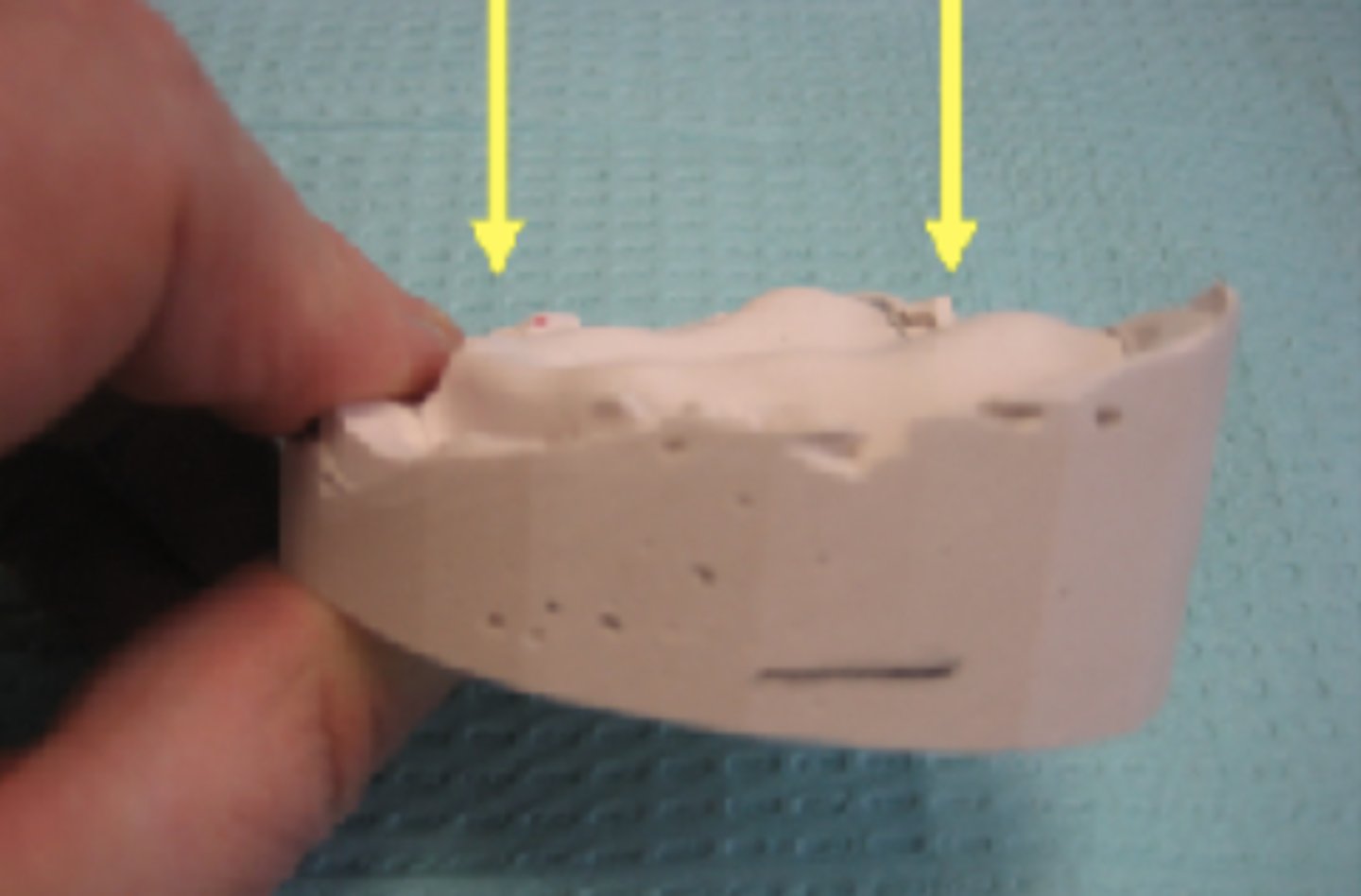
Define the following:
_______ is from the midline crest of the residual ridge, anteriorly, to the crests of the left and right tuberosities, posteriorly.
mean foundation plane of the maxillary cast
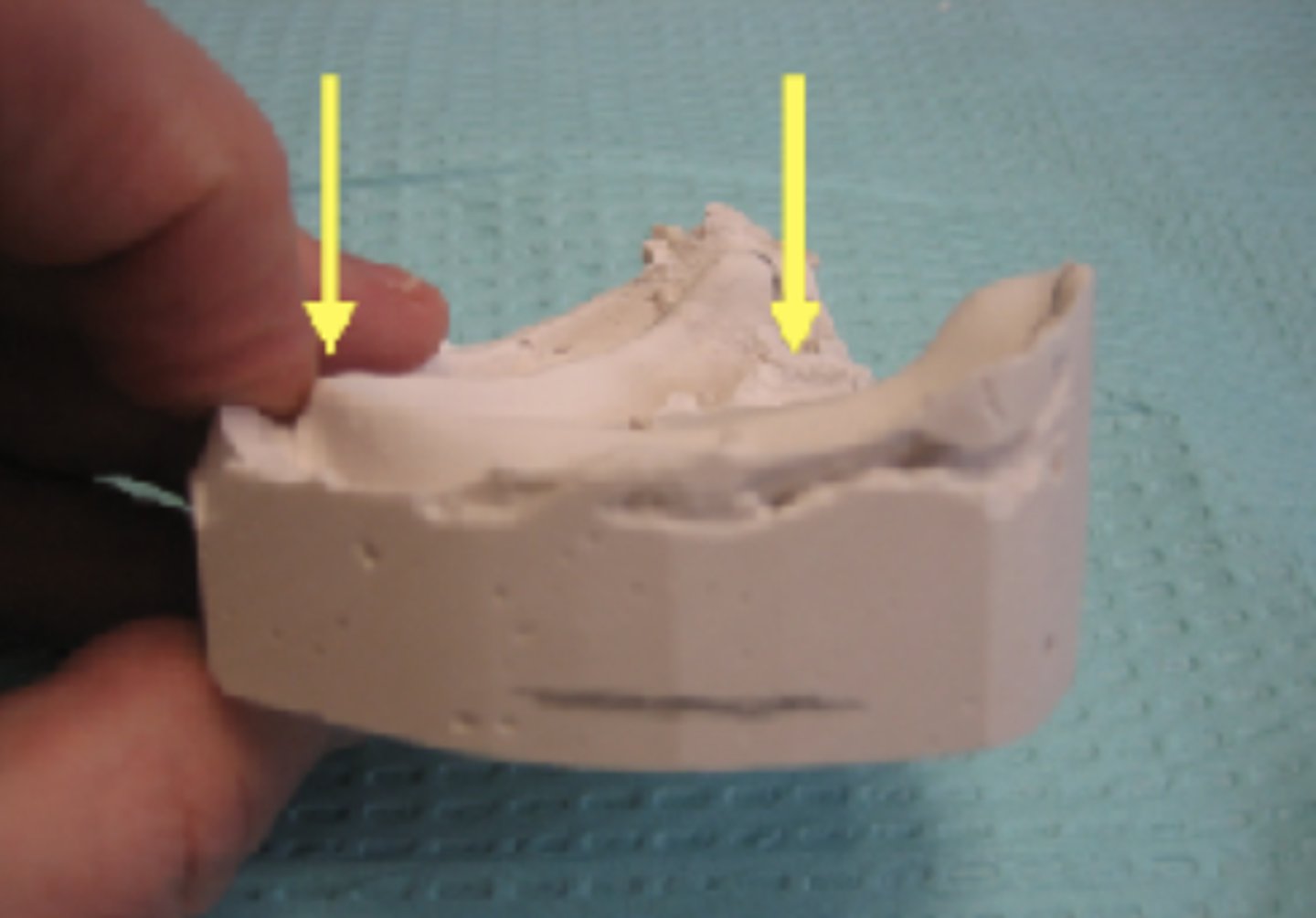
Define the following:
________ is from the crest of the residual ridge in the anterior region to the area where the ascending rami begin in the posterior region.
mean foundation plane (MFP) for the mandible cast
T/F: The posterior points of references for the mean foundation plane (MFP) for the mandible cast are the left and right retromolar pads.
FALSE - they are NOT (it is the crest of the residual ridge in the anterior region to the area where the ascending rami begin in the posterior region)
What is the degree of bevel needed around the entire cast prior to making the custom trays?
45 degrees
On the model trimmer, remove all of the excess plaster from the sides of the base portion of the maxillary and mandibular cast. Trim these areas up to a surface which is about _____mm lateral to the depth line of the facial peripheral roll line.
10mm
When you adjust the thickness of the base for a preliminary cast, the palatal vault is the thinnest area and should be about ____ mm thick
15mm
About how many clinical visits does it take to complete a set of complete dentures?
5-6
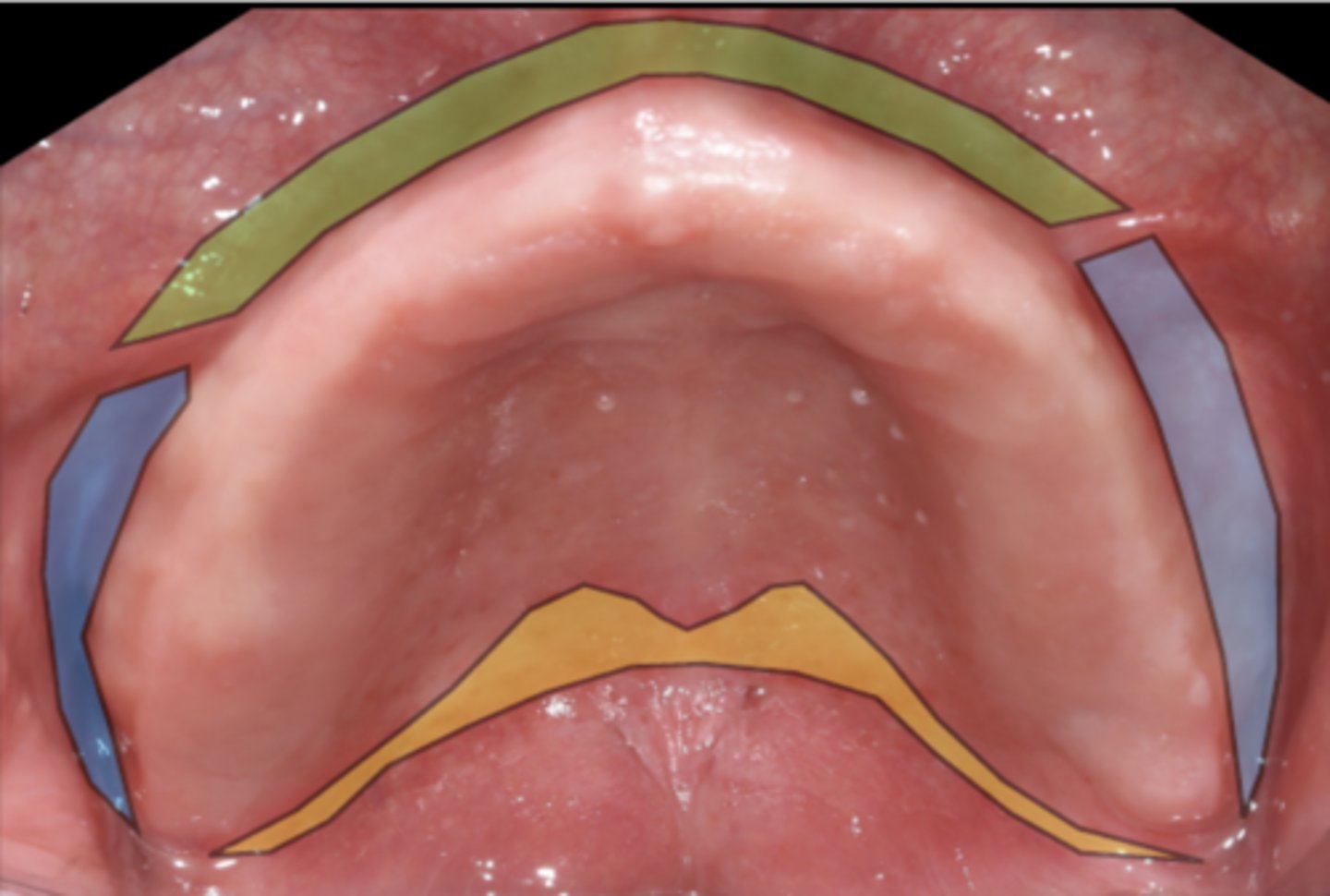
ID the area in green:
Labial vestibule
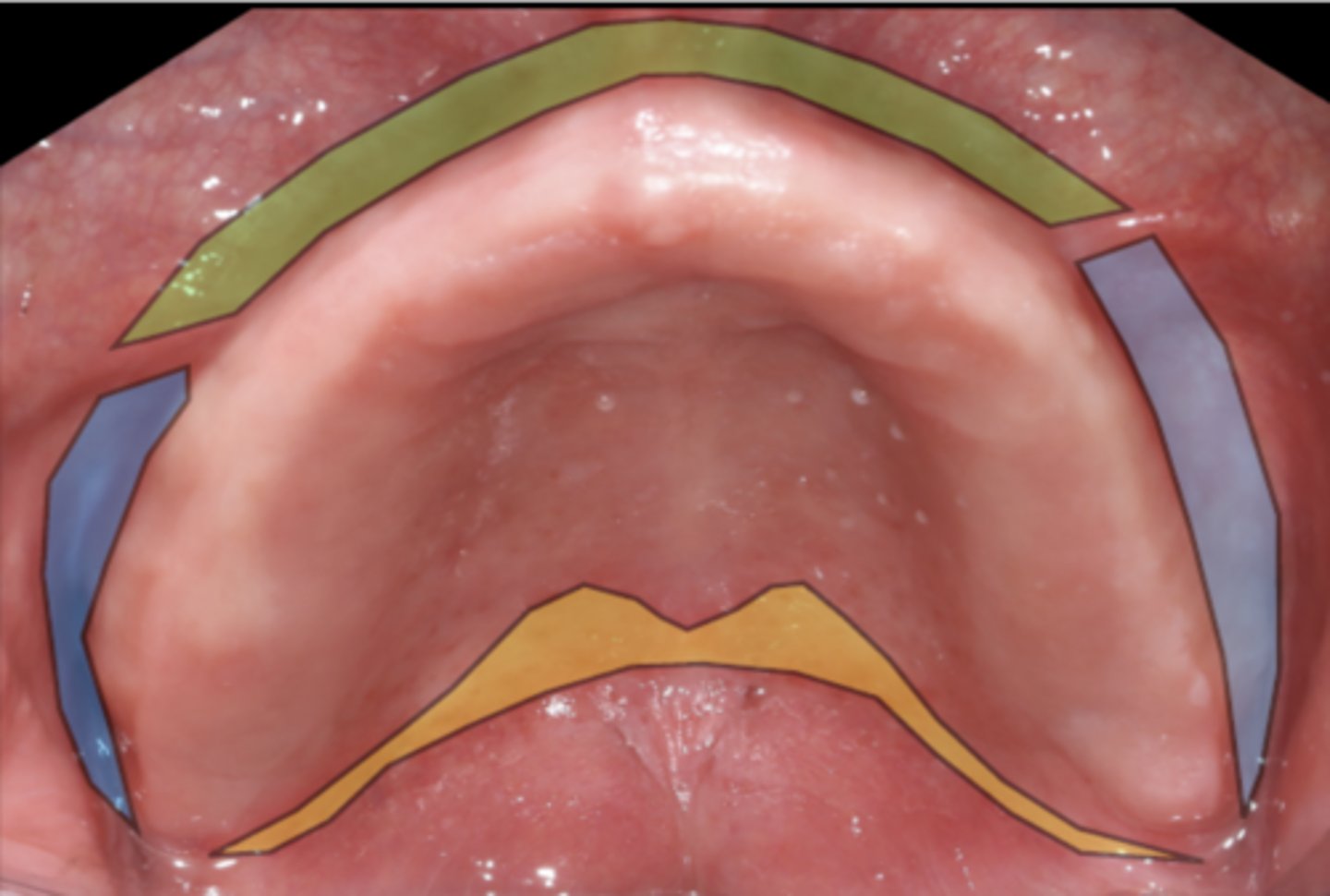
ID the area in blue:
Buccal vestibule

ID the area in yellow:
Posterior palatal seal
What has the following characteristics:
- Limiting structures: from buccal frenum to buccal frenum on the labial side of the maxillary ridge.
- Includes: Labial frenum, orbicularis oris.
Labial vestibule
What has the following characteristics:
Fold of mucous membrane at the median line. It contains no muscle and has no action of its own. The labial notch of the denture should be just wide enough and just deep enough to allow the frenum to pass through it without manipulation of the lip.
Labial Frenum
What has the following characteristics:
- Main muscle of the lips. It lies and rests upon the labial flange and teeth of a denture.
- Its tone depends on the support it receives from the thickness of the labial flange and the position of the teeth on the arch.
Orbicularis oris
the labial vestibule comprises what muscle?
obicularis oris
the lips are normally supported by what structures?
labial flange and cervical 3rd of teeth
the labial frenum provides attachment/support for what muscle?
none
What has the following characteristics:
Limiting structures: from the buccal frenum to the hamular notch (synonym: pterygo-maxillary notch)
Maxillary buccal vestibule
The _________ frenum is sometimes single, sometimes double, and sometimes broad and fan-shaped
Buccal
What requires more clearance: the buccal or lingual frenum?
Buccal
the buccal frenum provides attachment/support for what muscle?
buccinator m.
The buccinator muscle in the cheek extends from the _________ (anteriorly) to the ____________ (posteriorly)
Buccal frenum, pterygo-mandibular raphe
Define the following:
Fissure situated between the tuberosity of the maxilla and the hamulus of the pterygoid plate
Pterygomaxillary notch or Hamular notch
What two structures form the hamular notch?
- Hamulus
- Maxillary tuberosity
What is the most distal extension of the maxillary denture?
posterior palatal seal area
What is the line between mobile and non-mobile soft palate?
posterior palatal seal area
What has the following characteristics:
- Location of anterior outline of _____; a ball-ended burnisher use to press gently against the hard palate and gradually worked backward until displaceable tissue could be located.
- Establishing depth; by pressing a ball-ended burnisher against soft tissue of _____ to approximate the amount of displacement.
Posterior palatal seal area
What has the following characteristics:
- Indentations near the midline of the palate that are formed by a coalescence of several mucous gland ducts.
- Landmark as the vibrating line is often anterior to
the __________
Fovae palatinae
To identify the vibrating line, what should the patient say?
"Ah"
What has the following characteristics:
- Located in the palate on the median line and comes nearer to the crest of the ridge as resorption progresses.
- Should be relieved routinely to prevent impingement on the nasopalatine nerves and blood vessels as they pass through the nasopalatine foramen
- Pressure in this area is interpreted by the patient typically as a "burning sensation"
Incisive papilla
The _______ is a thickness of tissue over the nasopalatine nerve and serves to help protect the neurovascular vessels
- Important anatomical landmark for fabricating wax rims and setting teeth as its position does not change much after teeth are extracted
incisive papilla
Define the following:
In the area of the rugae, the palate is set at an angle to the residual ridge and is rather thinly covered by soft tissue.
Palatal rugae
Define the following:
As it resorbs and may have some nutrient canal and sharp spicules of bone or when the crest of the ridge is knife-edge shaped
Residual ridge
What has the following characteristics:
- The most distal portion of the maxillary alveolar ridge.
- Needs to be assessed prior to starting treatment as it often extrudes leading to a lack of prosthetic space
- It has tendency of enlargement
maxillary tuberosity

ID the structure:
Maxillary tuberosity
What has the following characteristics:
In the region of the medial ___________, the submucosa is extremely thin, with the result that the submucosa is practically in contact with the bone. For this reason, the soft tissue covering the ___________ is non-resilient and may need to be relieved to avoid trauma from the denture base.
Palatal suture
The mandibular labial vestibule is limited inferiorly by the _________ muscle
Mentalis
What has the following characteristics:
- Limiting structures: from the buccal frenum to the lateral aspect of the retromolar pad.
- Includes: buccal frenum, buccinator, masseter.
Mandibular buccal vestibule
What muscle keeps food in but the cheek and air out?
Buccinator
What muscle is for powerful jaw closure and protrusion?
Masseter
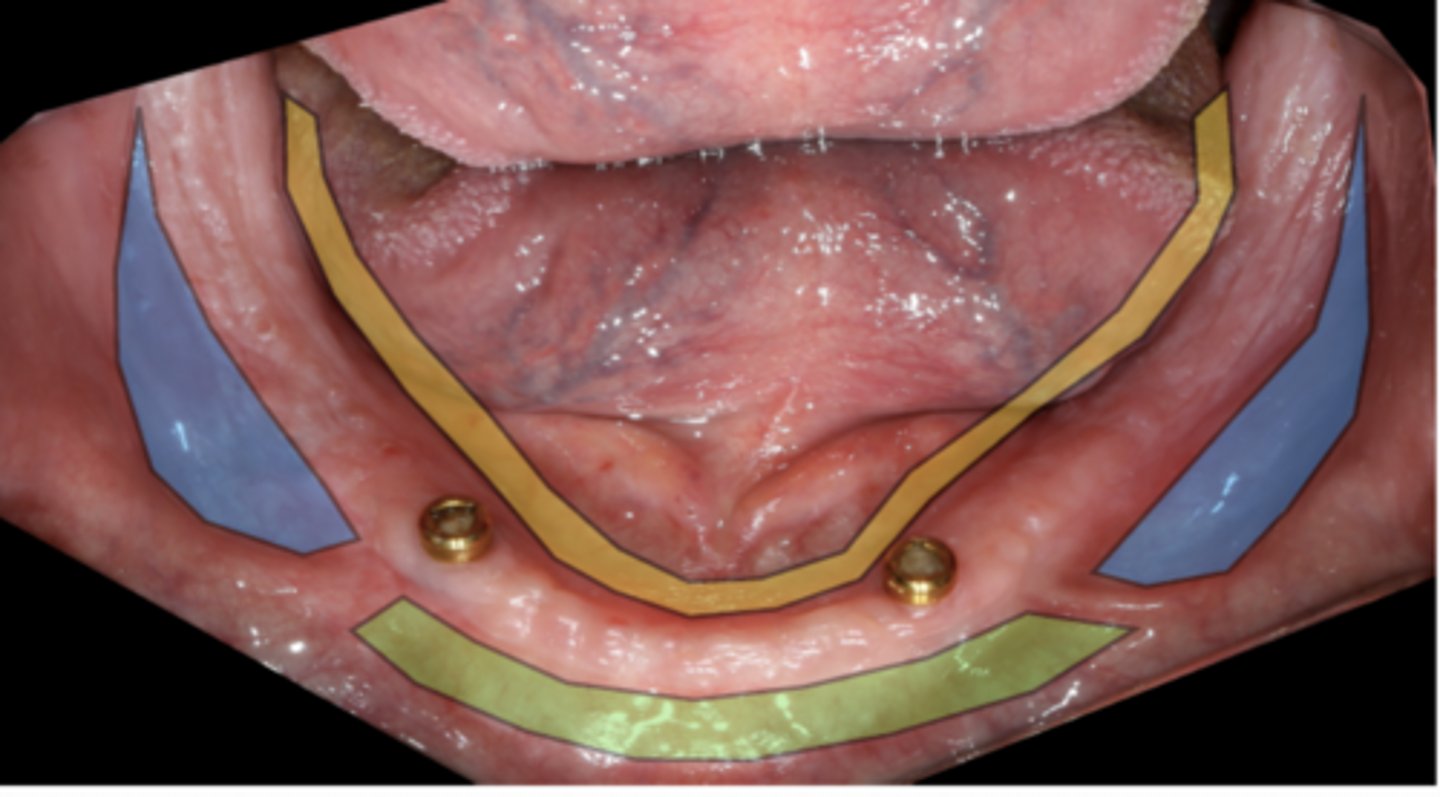
ID the region in green:
Labial vestibule
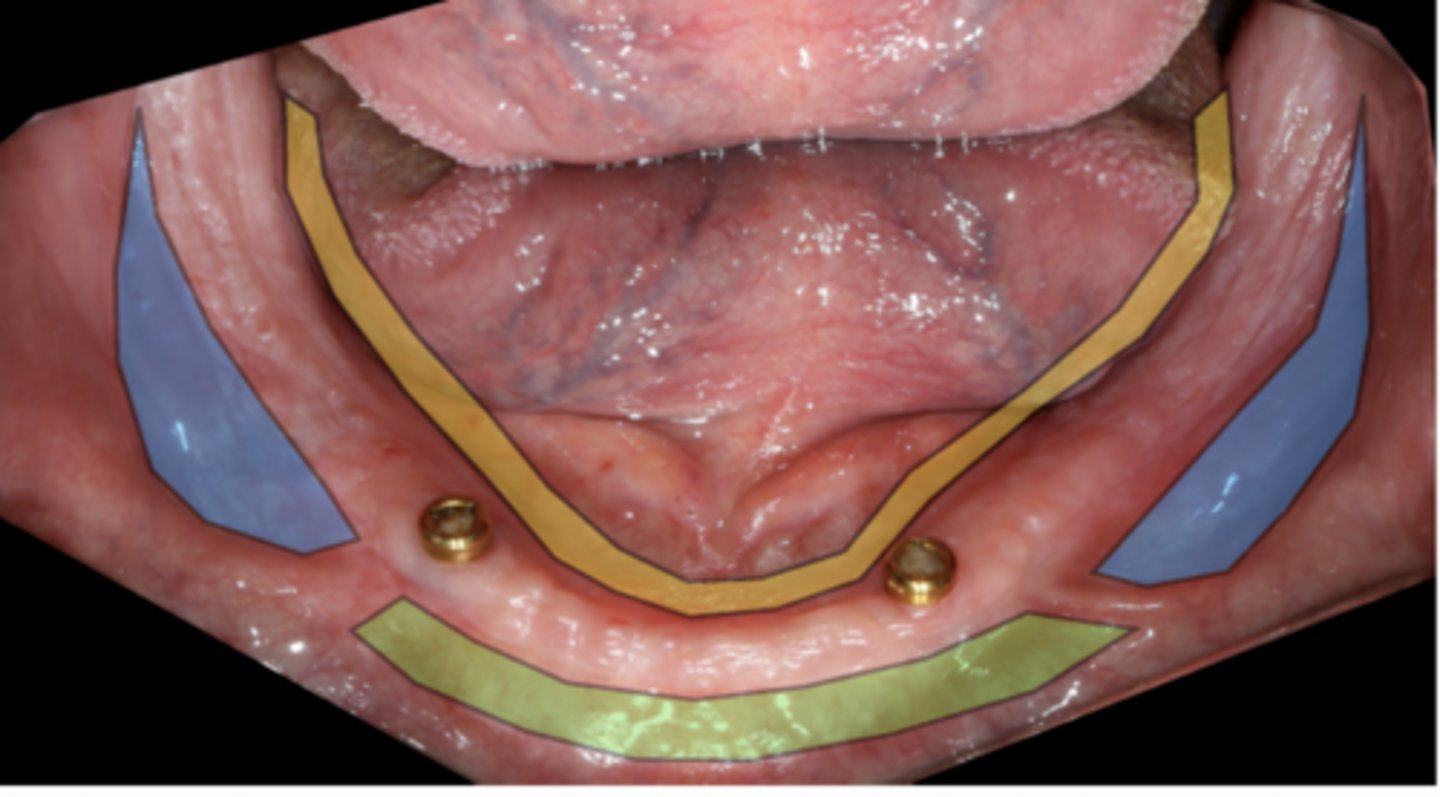
ID the region in blue:
Buccal vestibule

ID the region in yellow:
Alveololingual sulcus
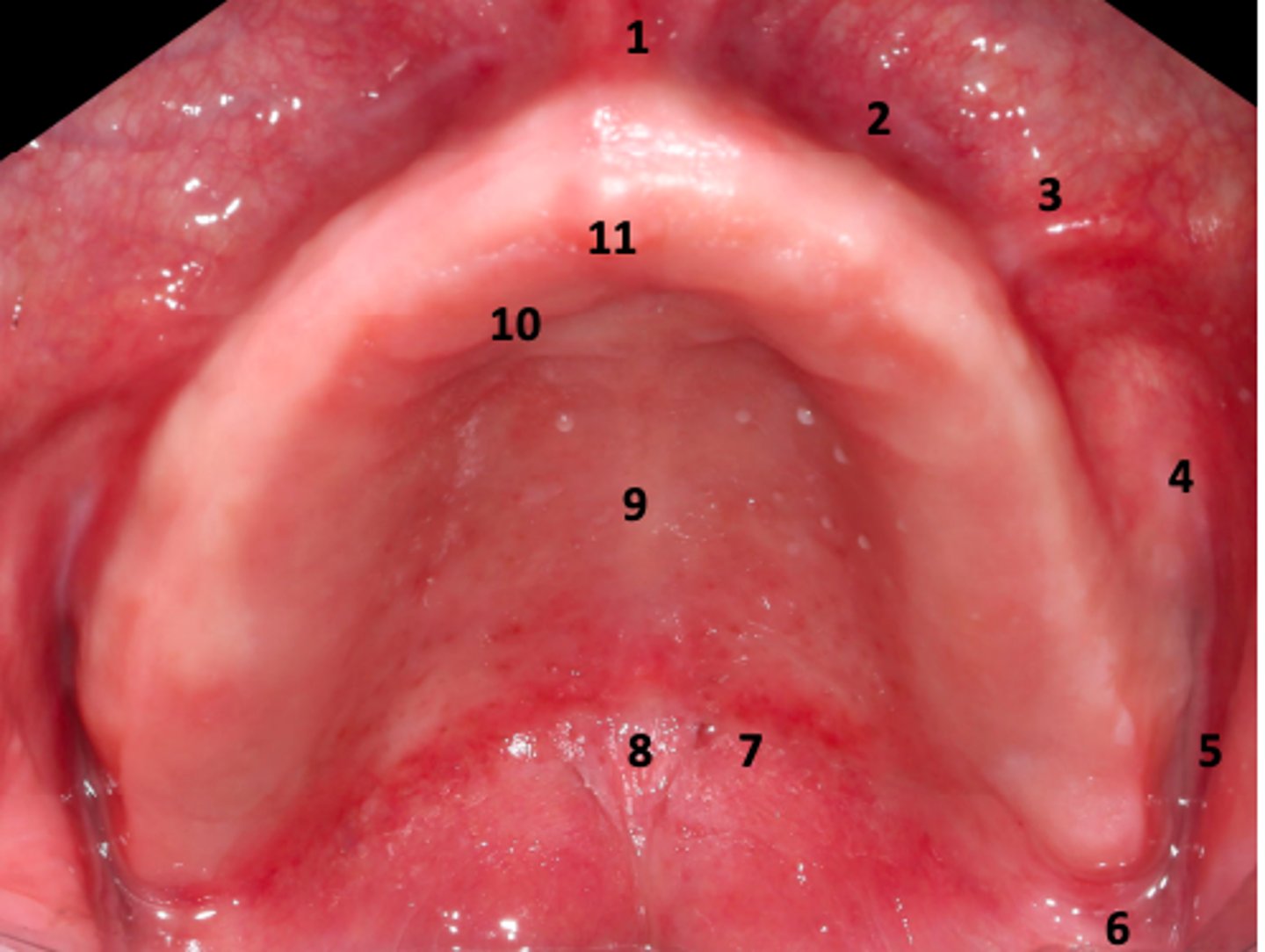
ID #1:
labial frenum
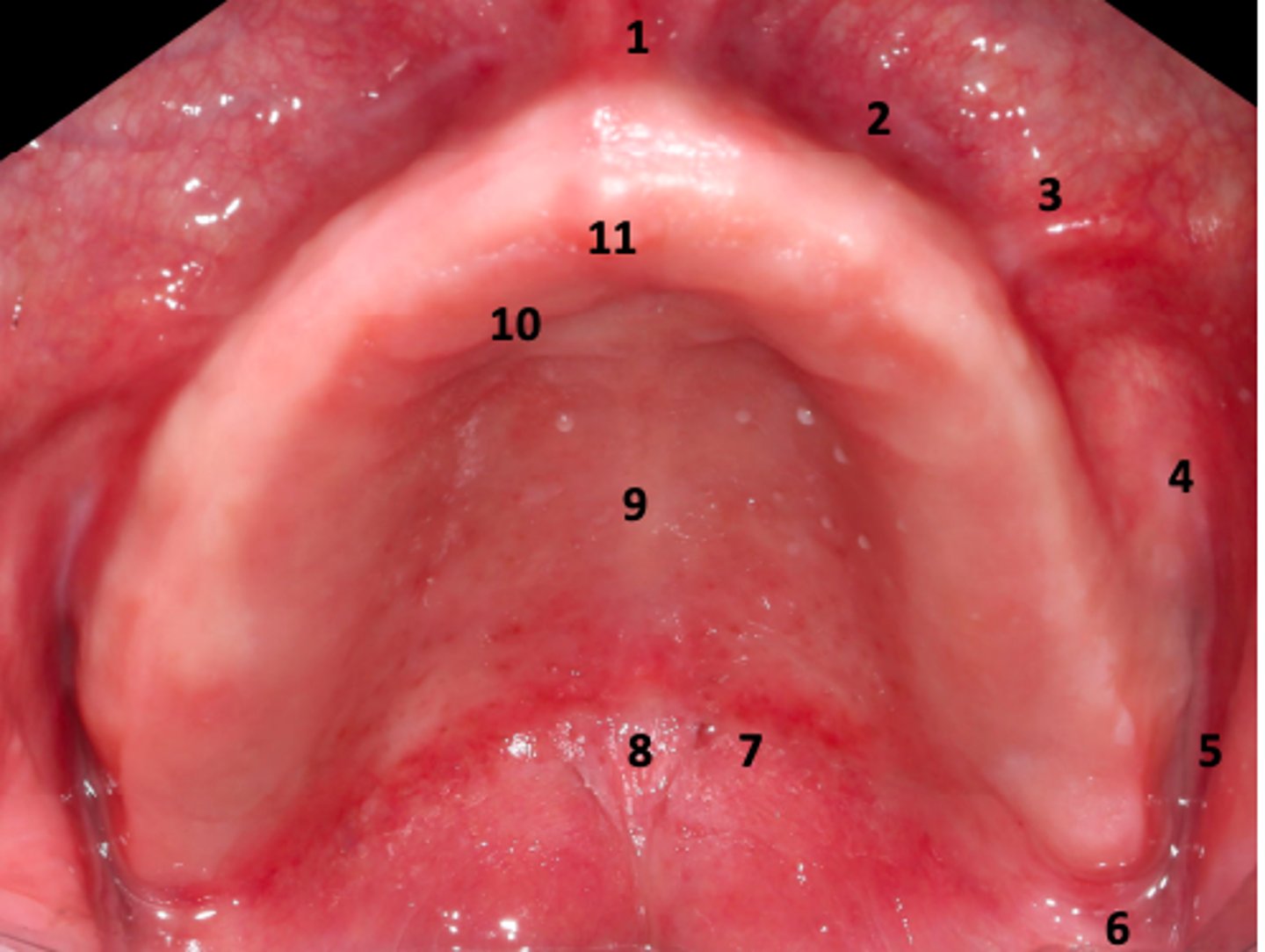
ID #2:
labial vestibule
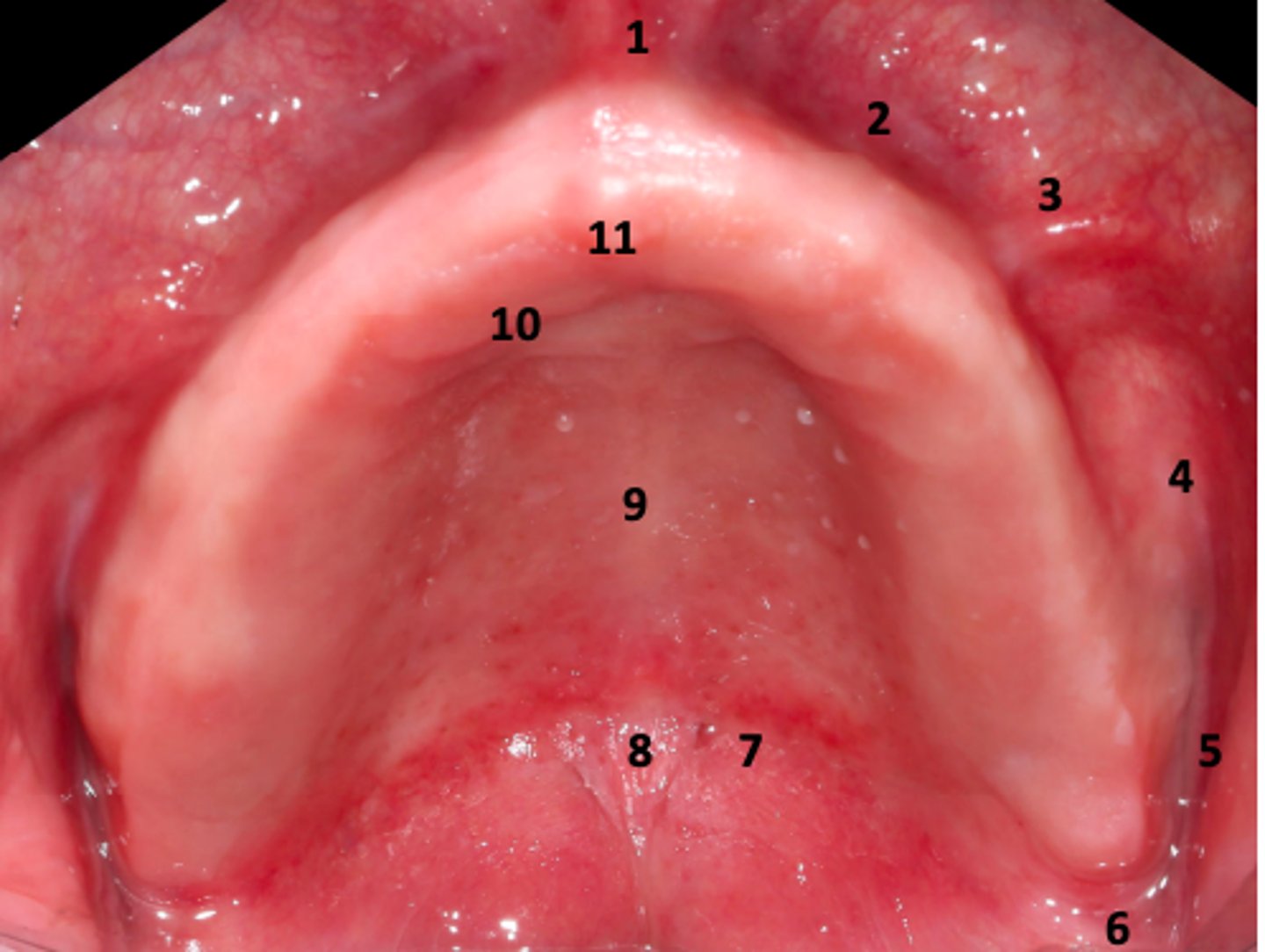
ID #3:
buccal frenum
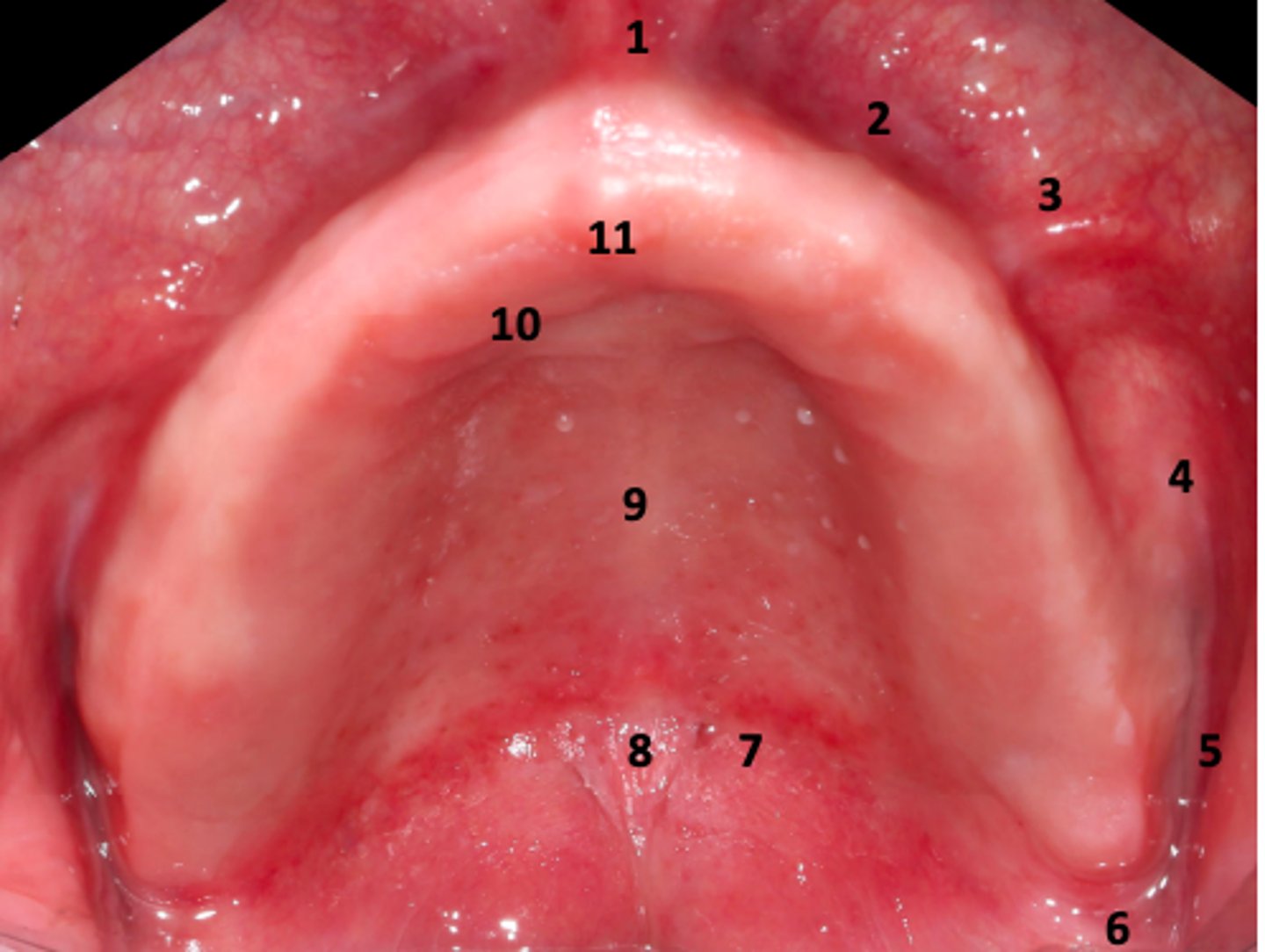
ID #4:
buccal vestibule
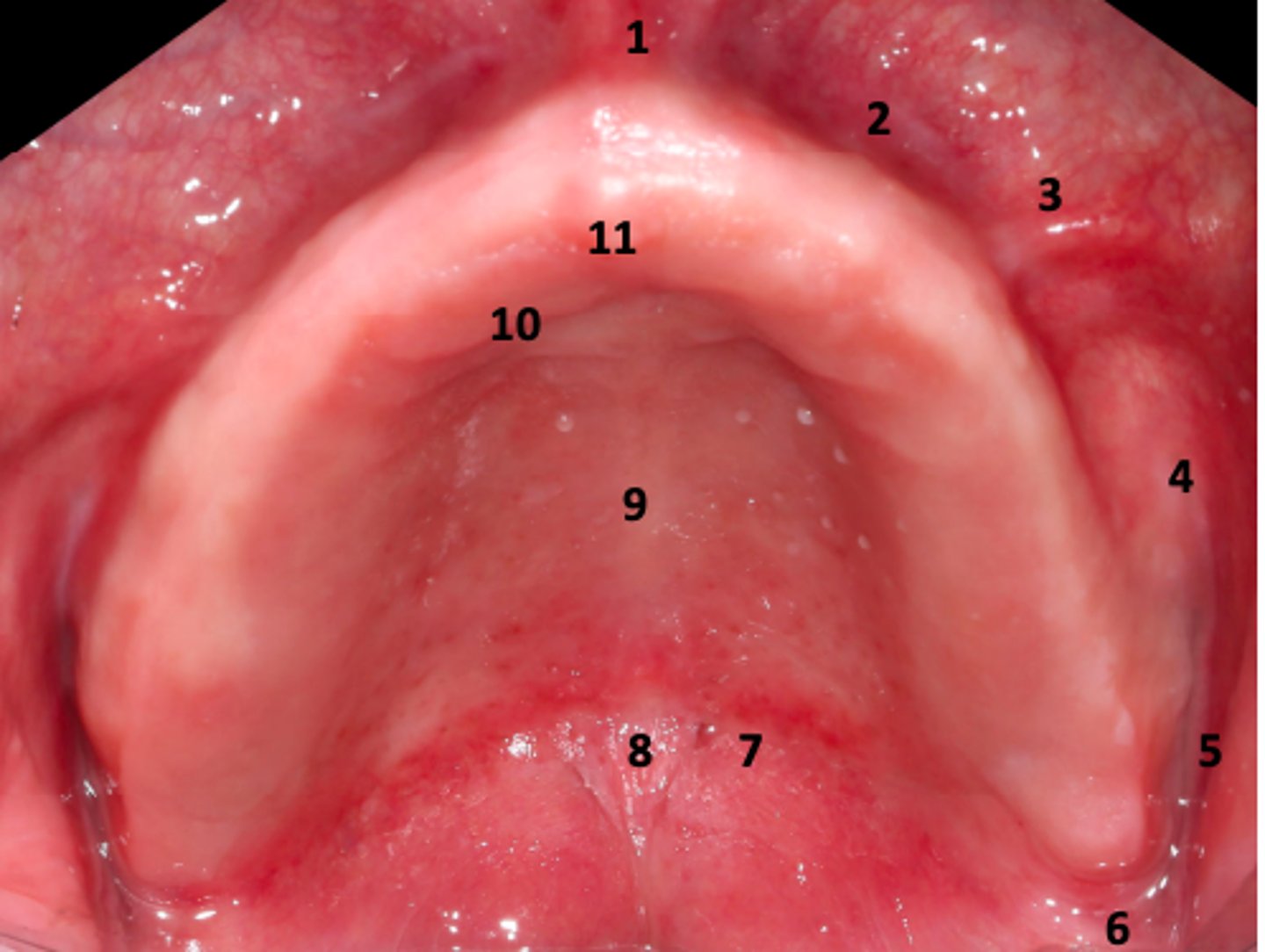
ID #5:
corono-maxillary space/Retro-zygomatic area
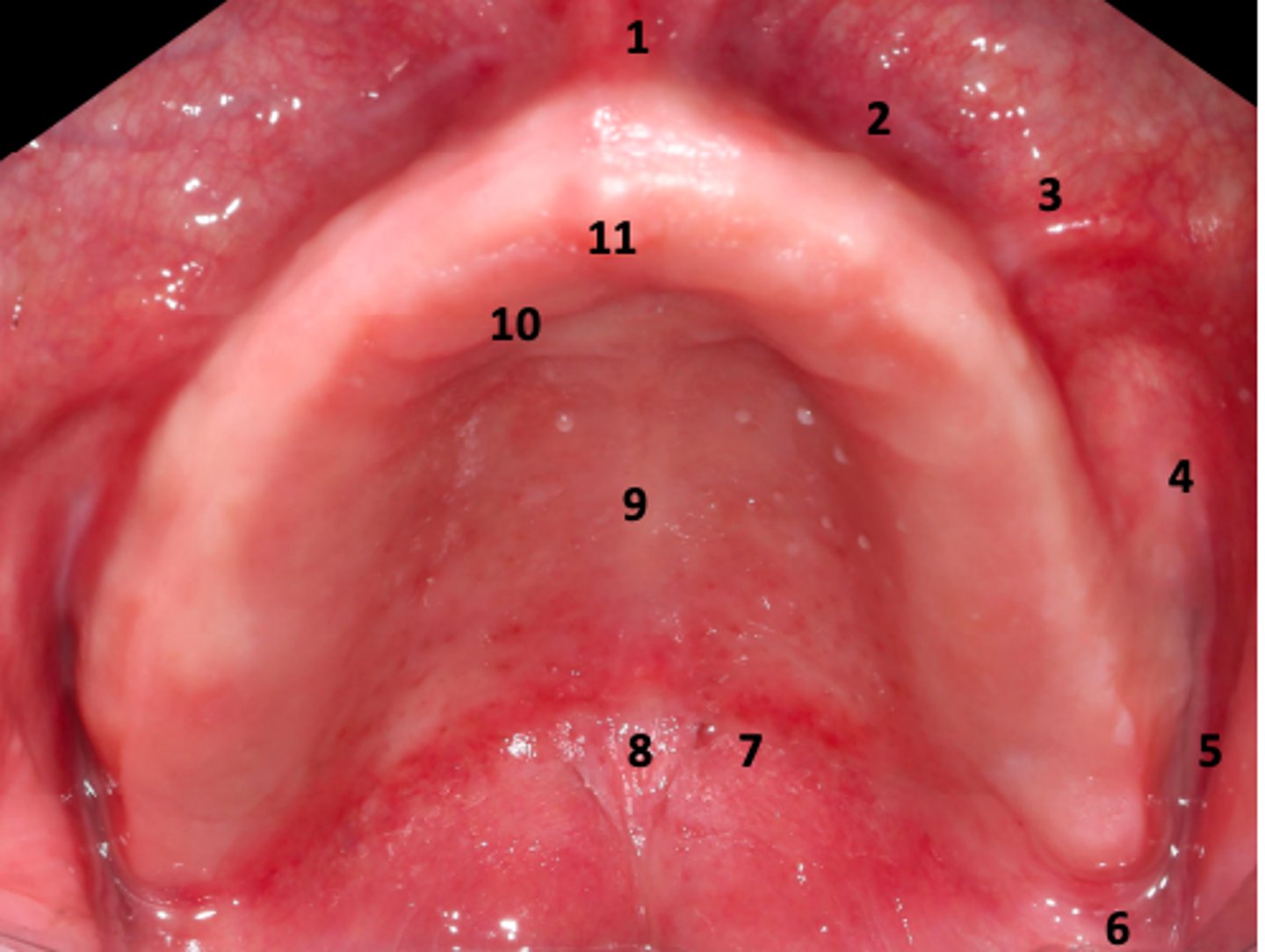
ID #6:
hamular notch (pterygomandibular notch)
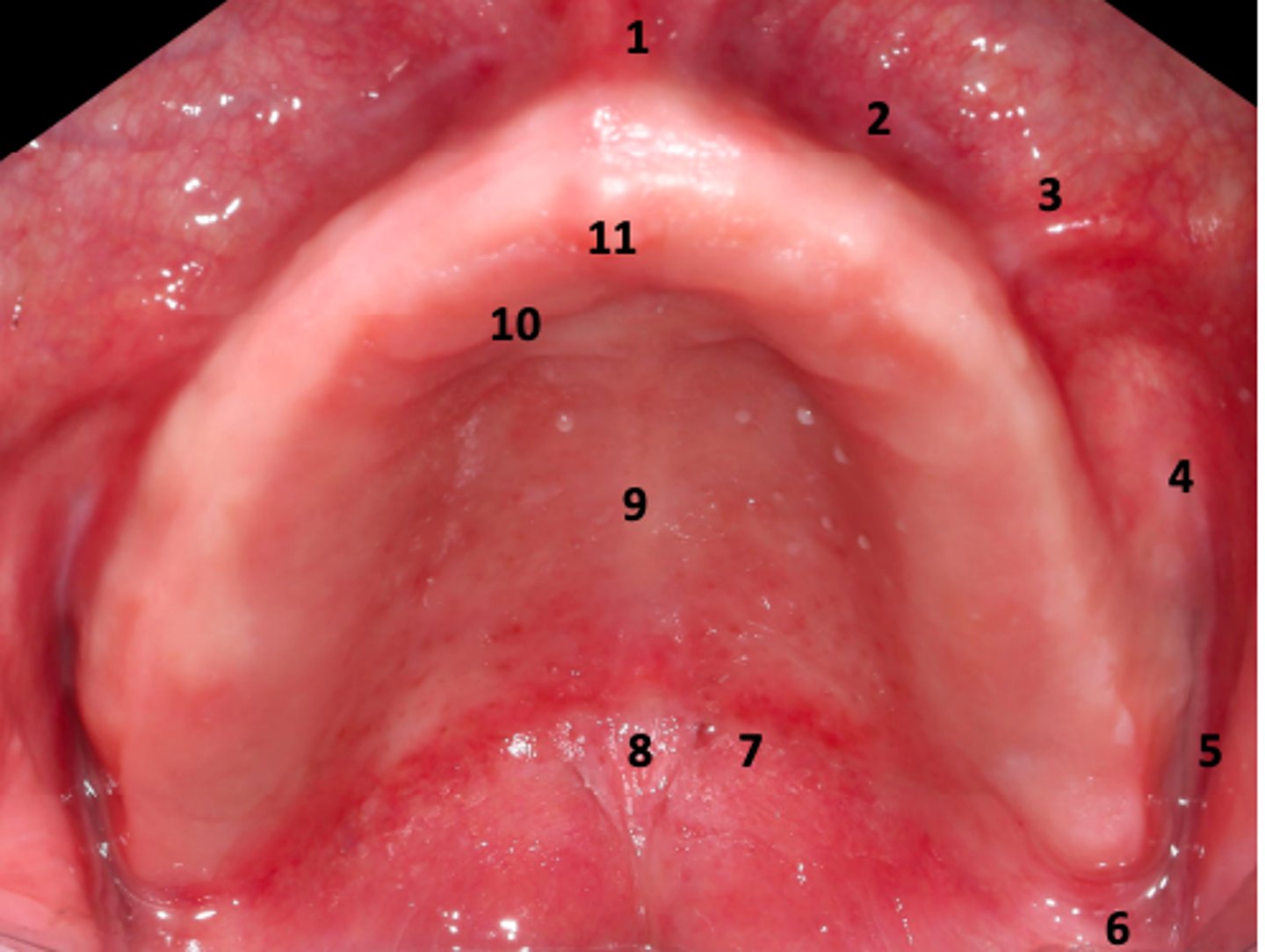
ID #7:
posterior palatal seal area
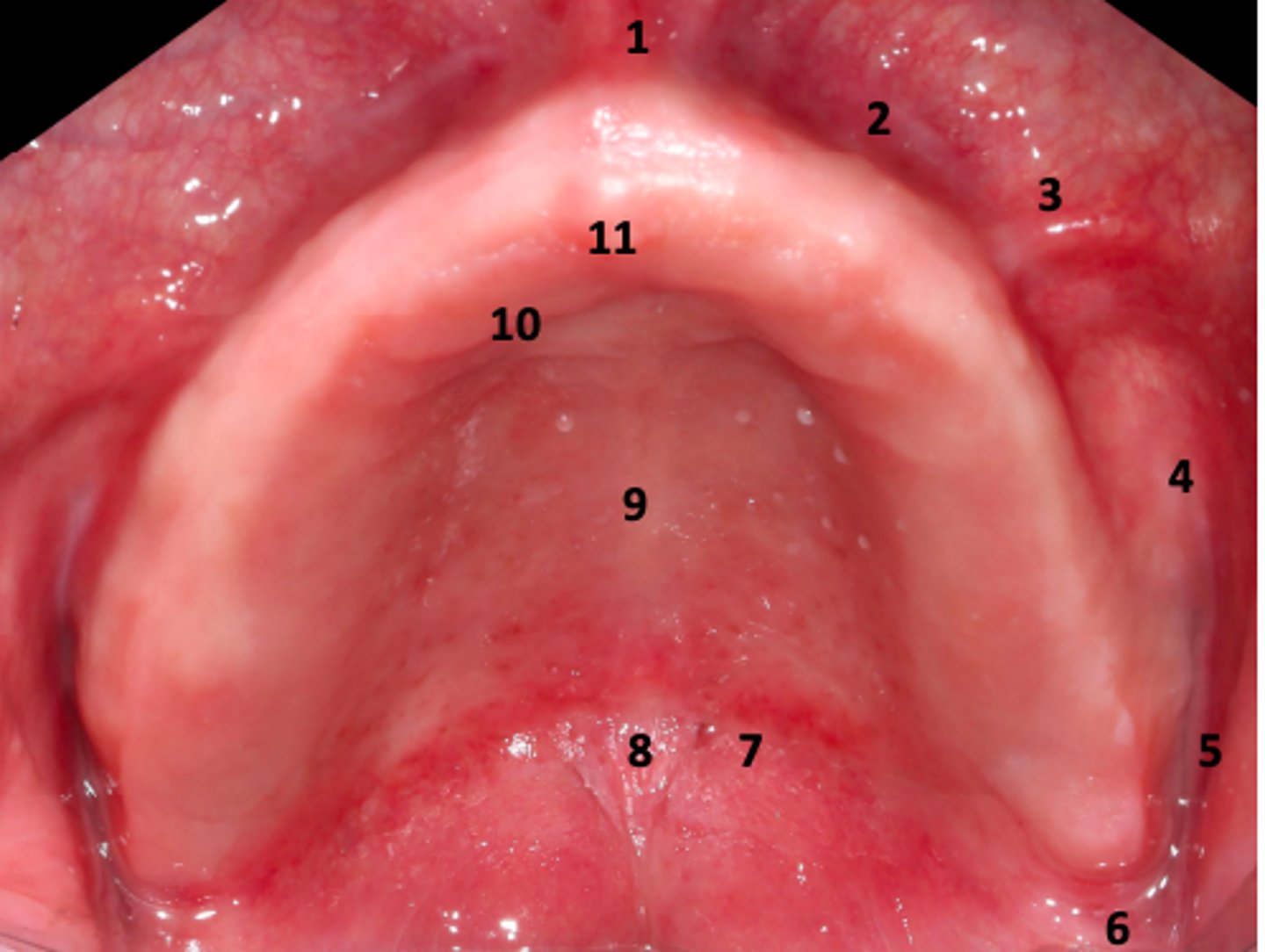
ID #8:
fovea palatine
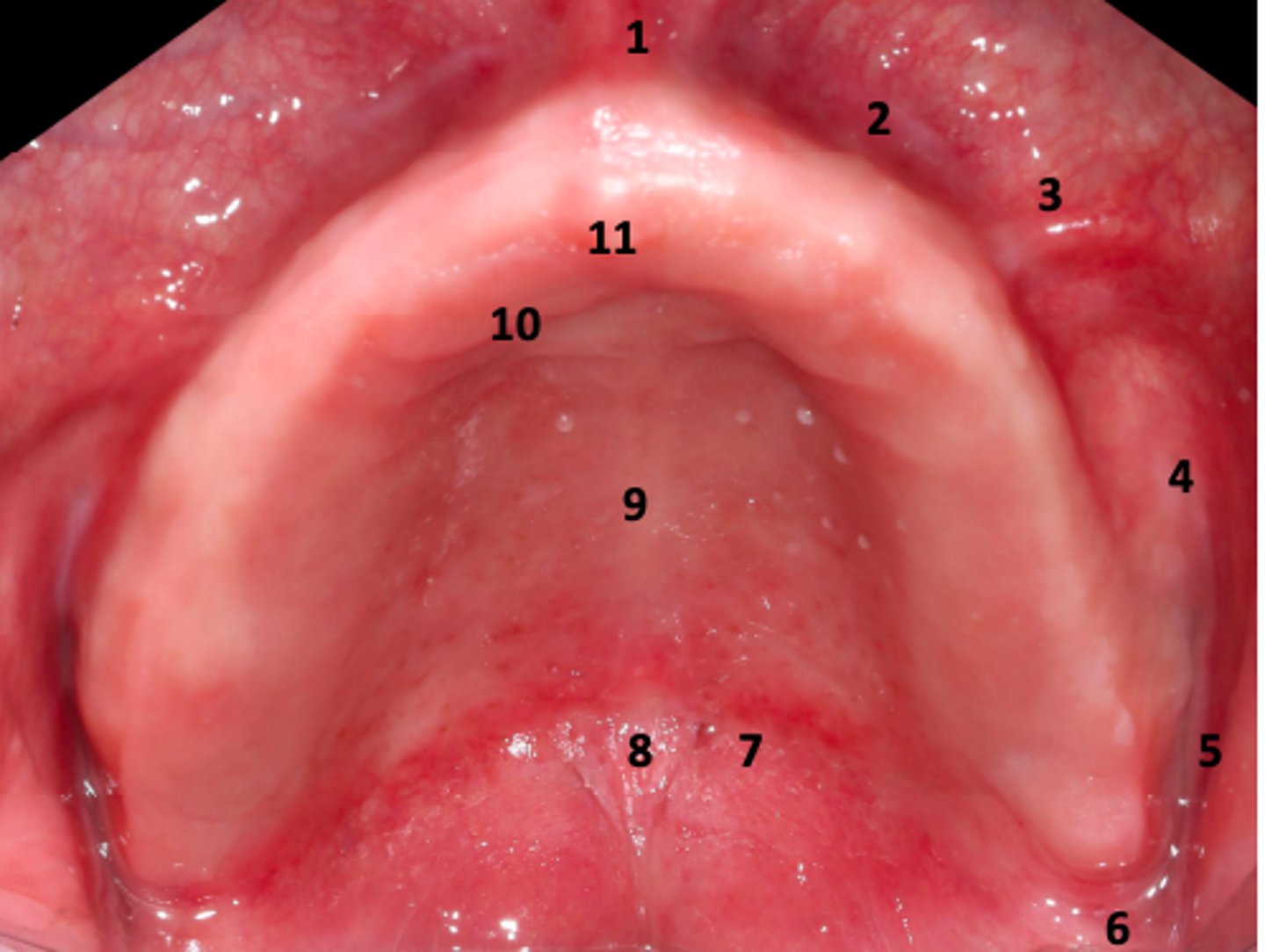
ID #9:
mid-palatal suture

ID #10:
maxillary rugae

ID #11:
incisive papilla
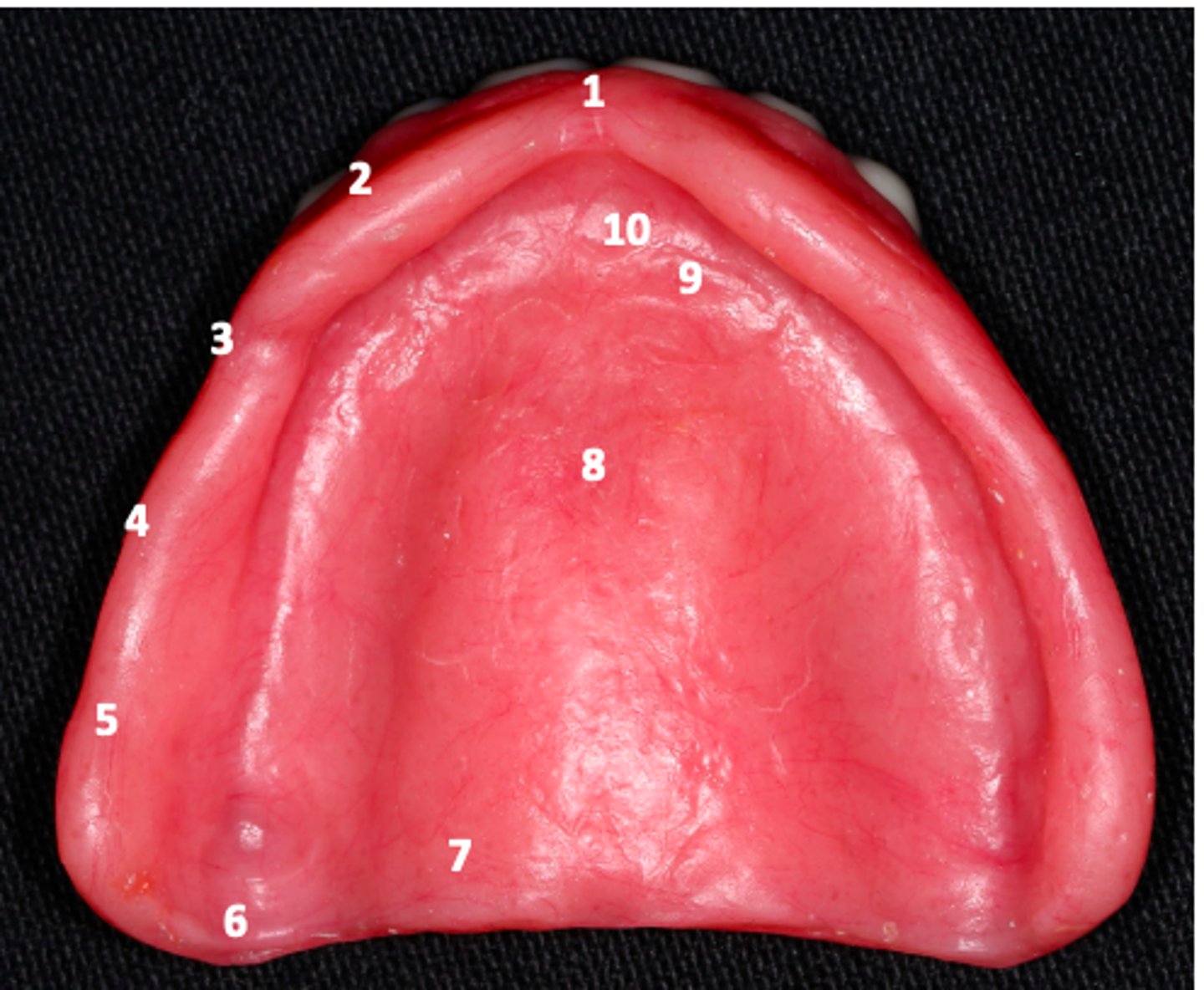
ID #1:
labial notch

ID #2:
labial flange
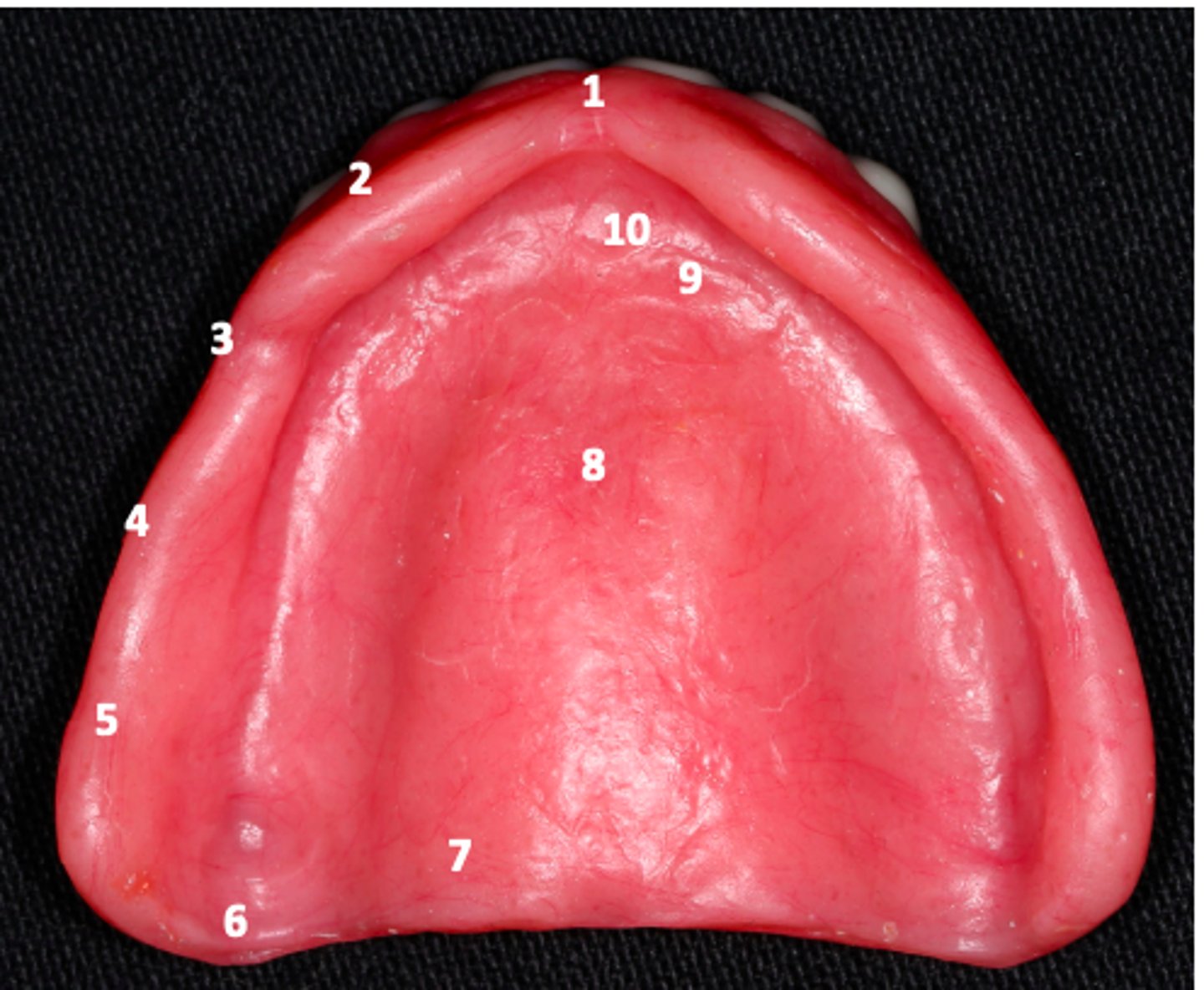
ID #3:
buccal notch
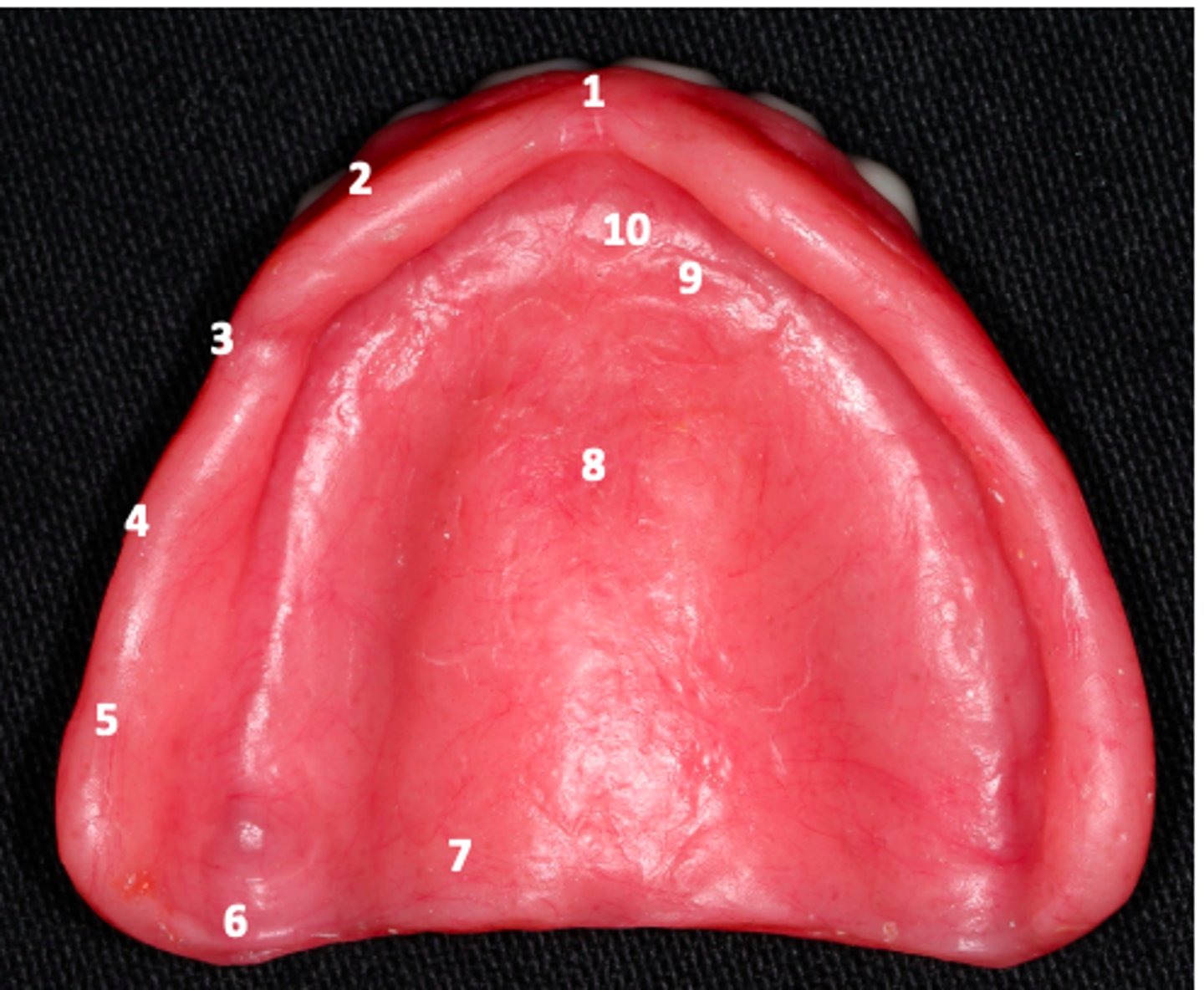
ID #4:
buccal flange
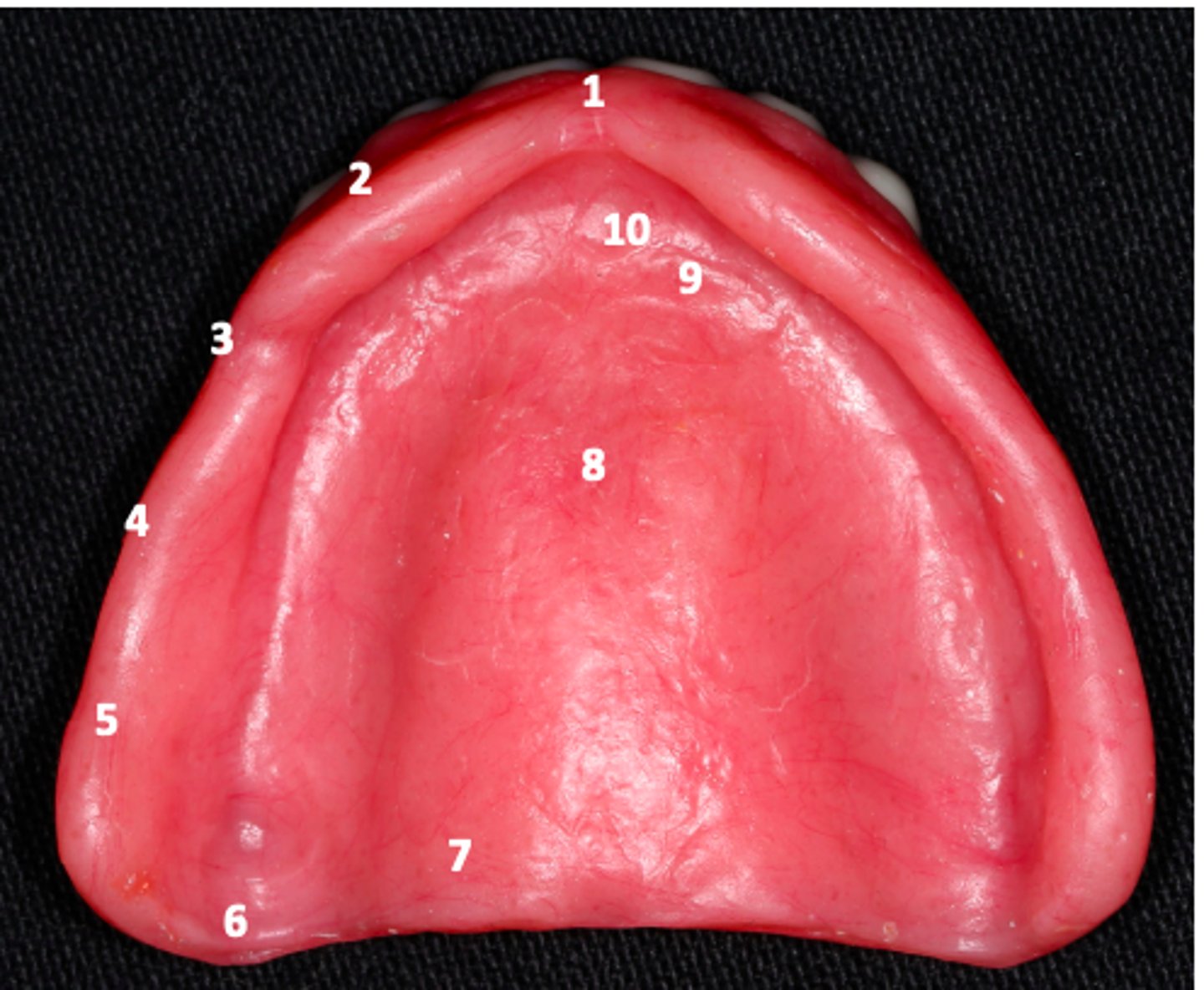
ID #5:
retro-zygomatic flange
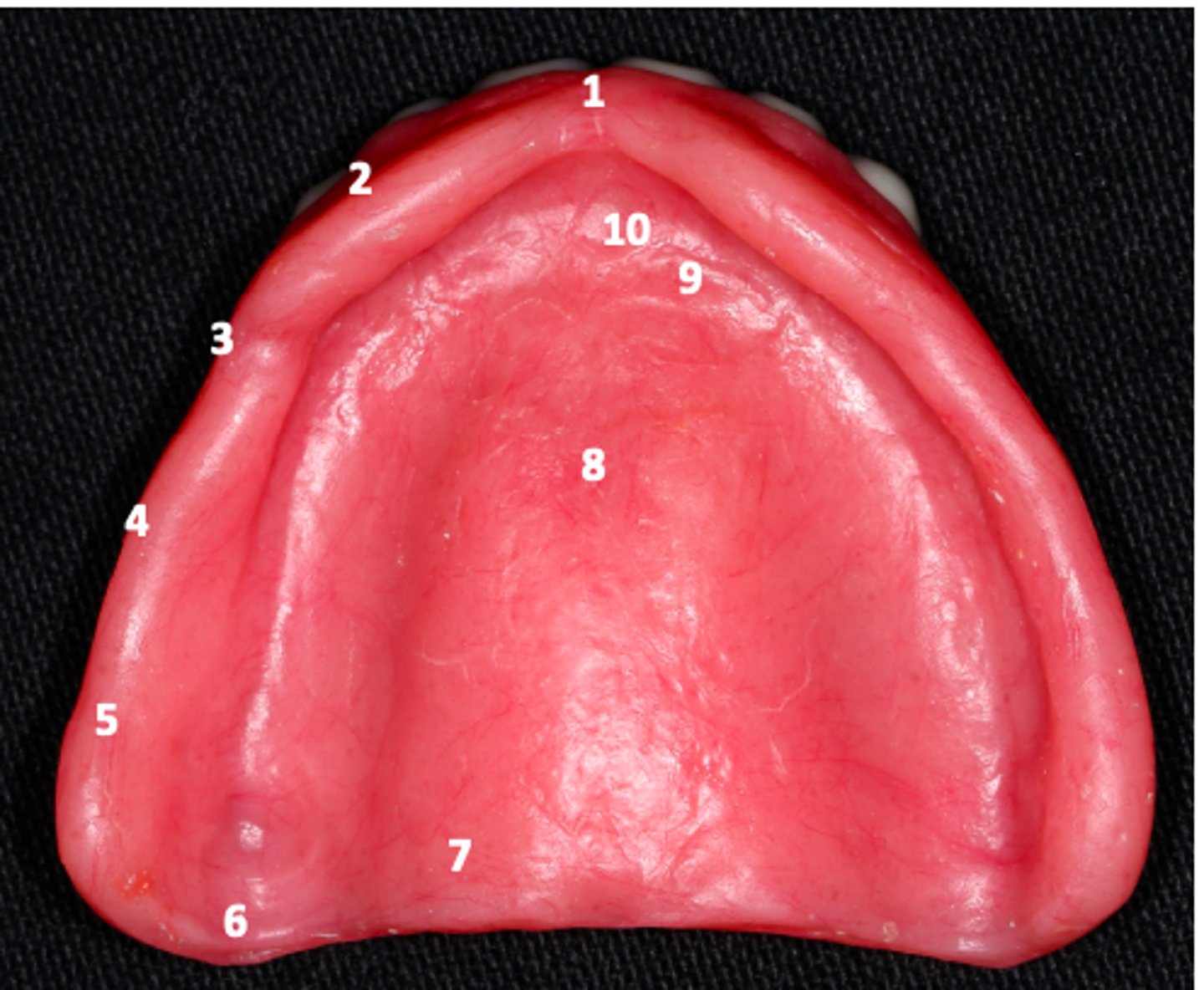
ID #6:
hamular notch/pterygomandibular notch
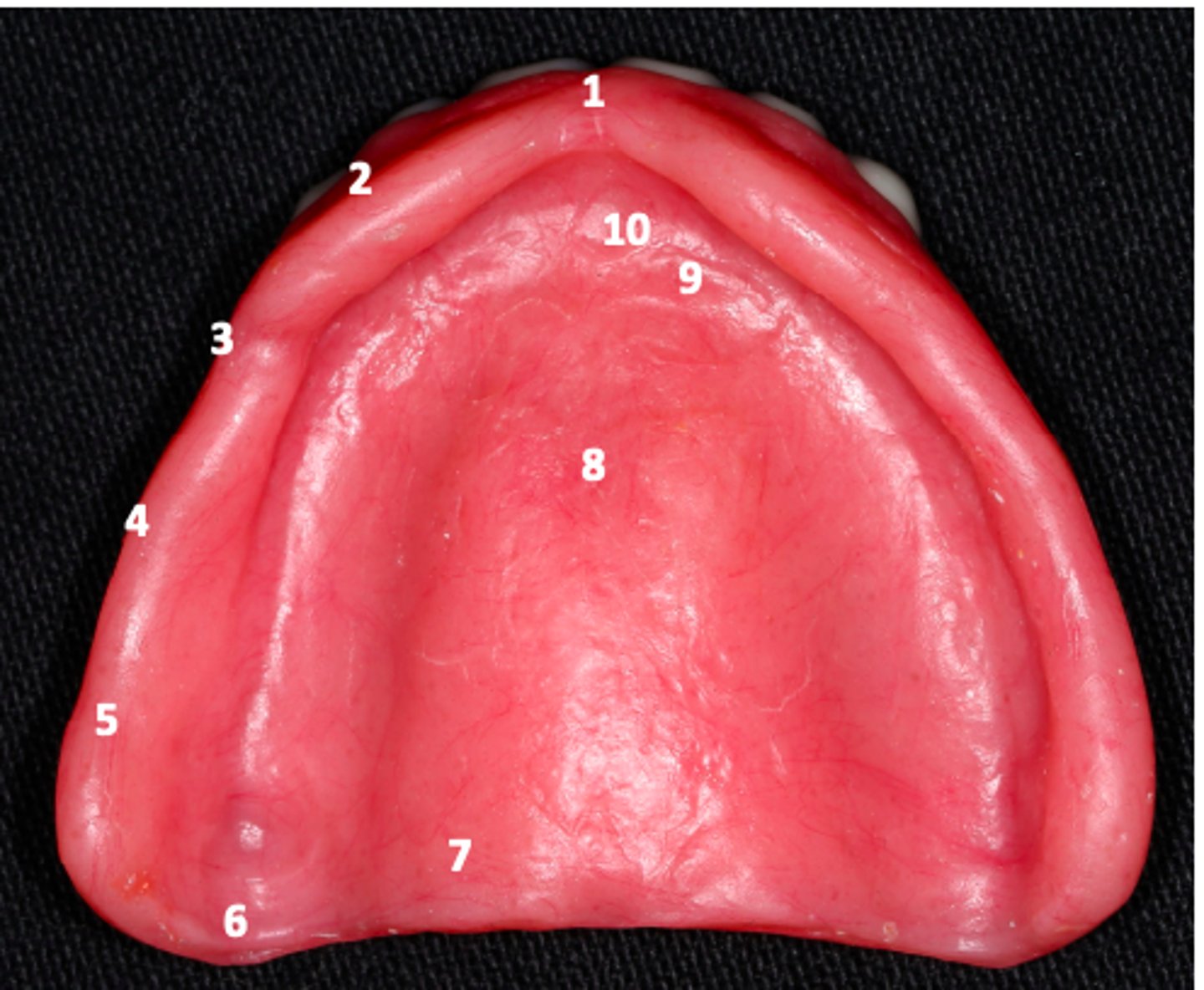
ID #7:
posterior palatal seal area
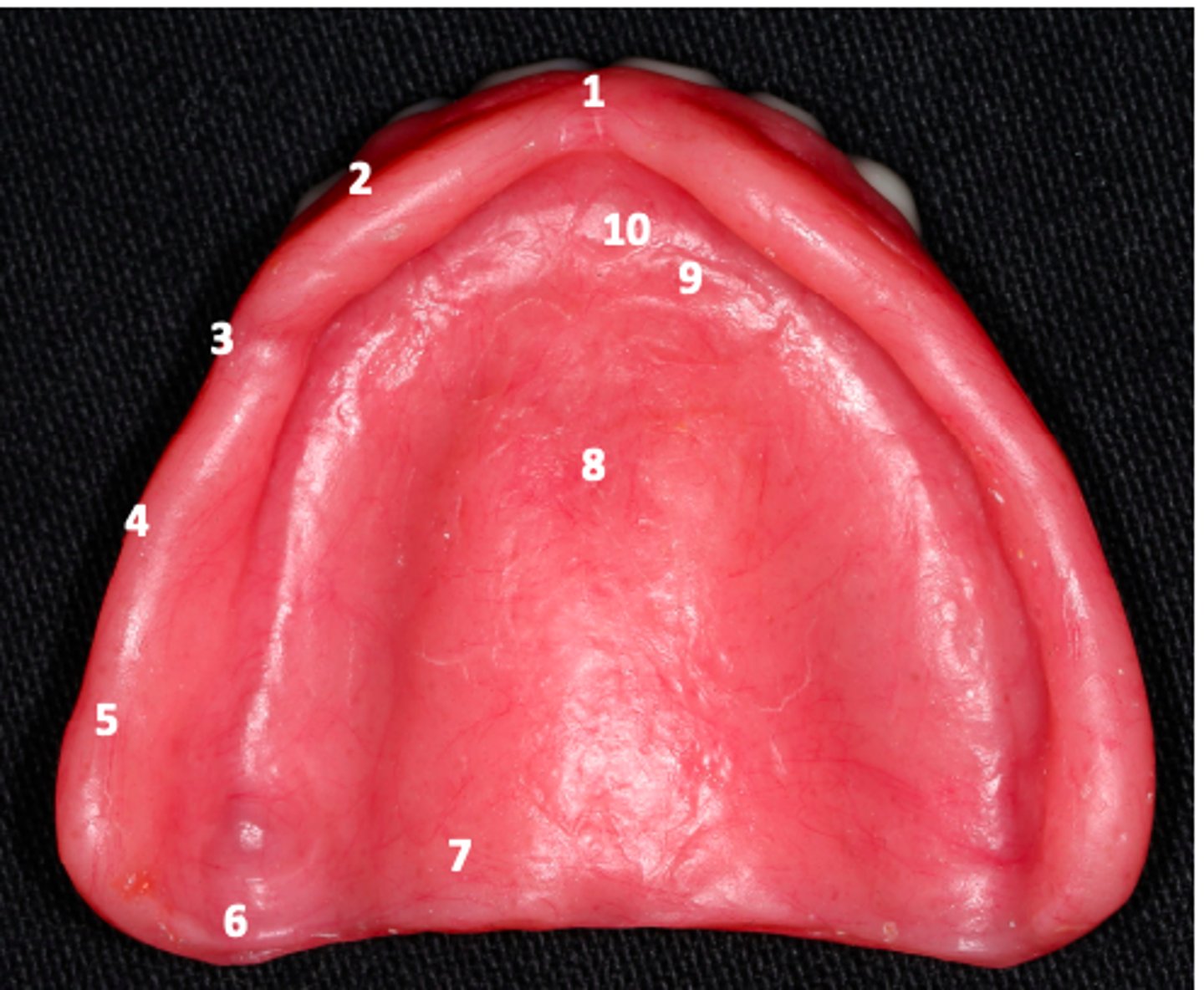
ID #8:
mid-palatal suture relief
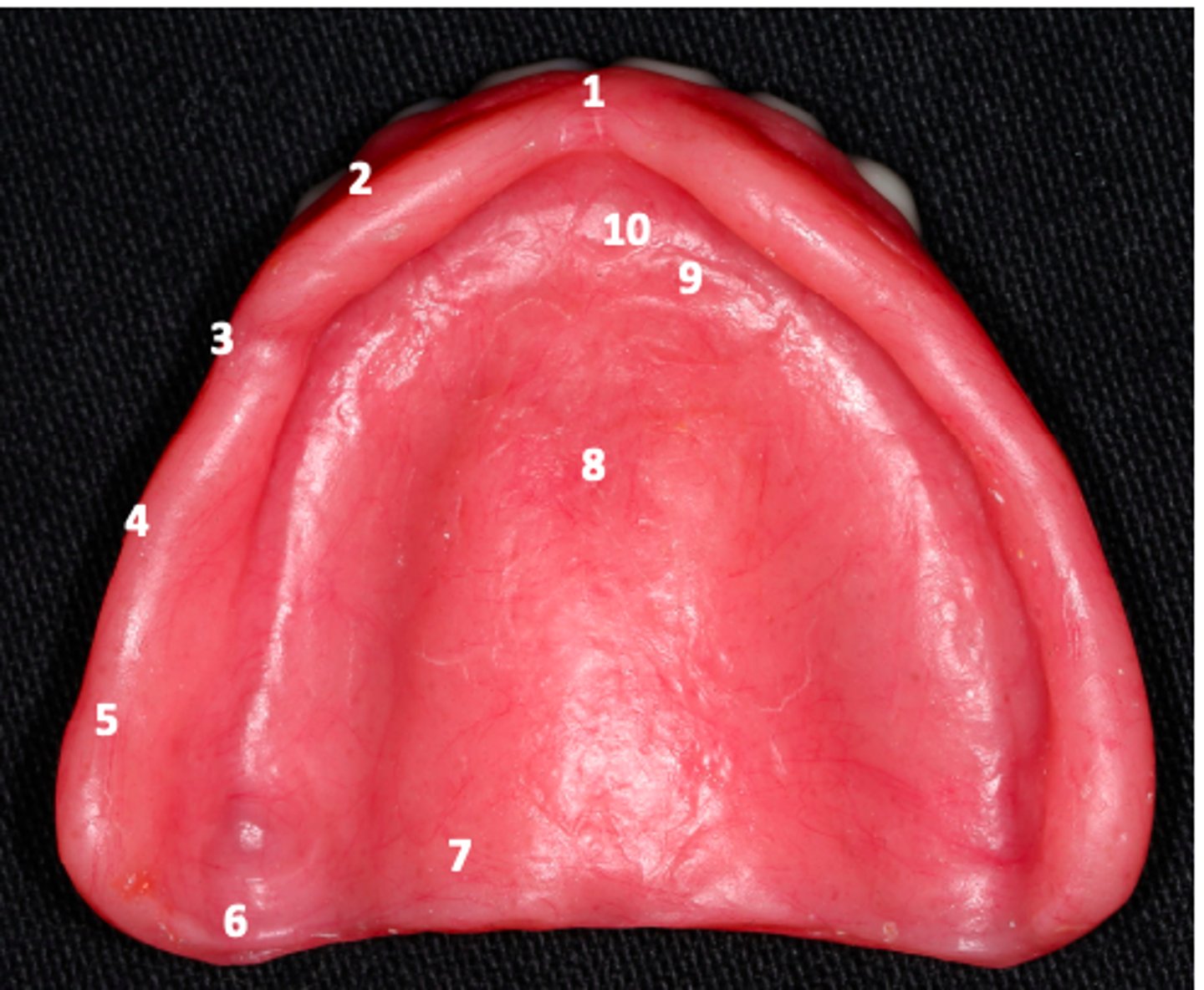
ID #9:
maxillary rugae
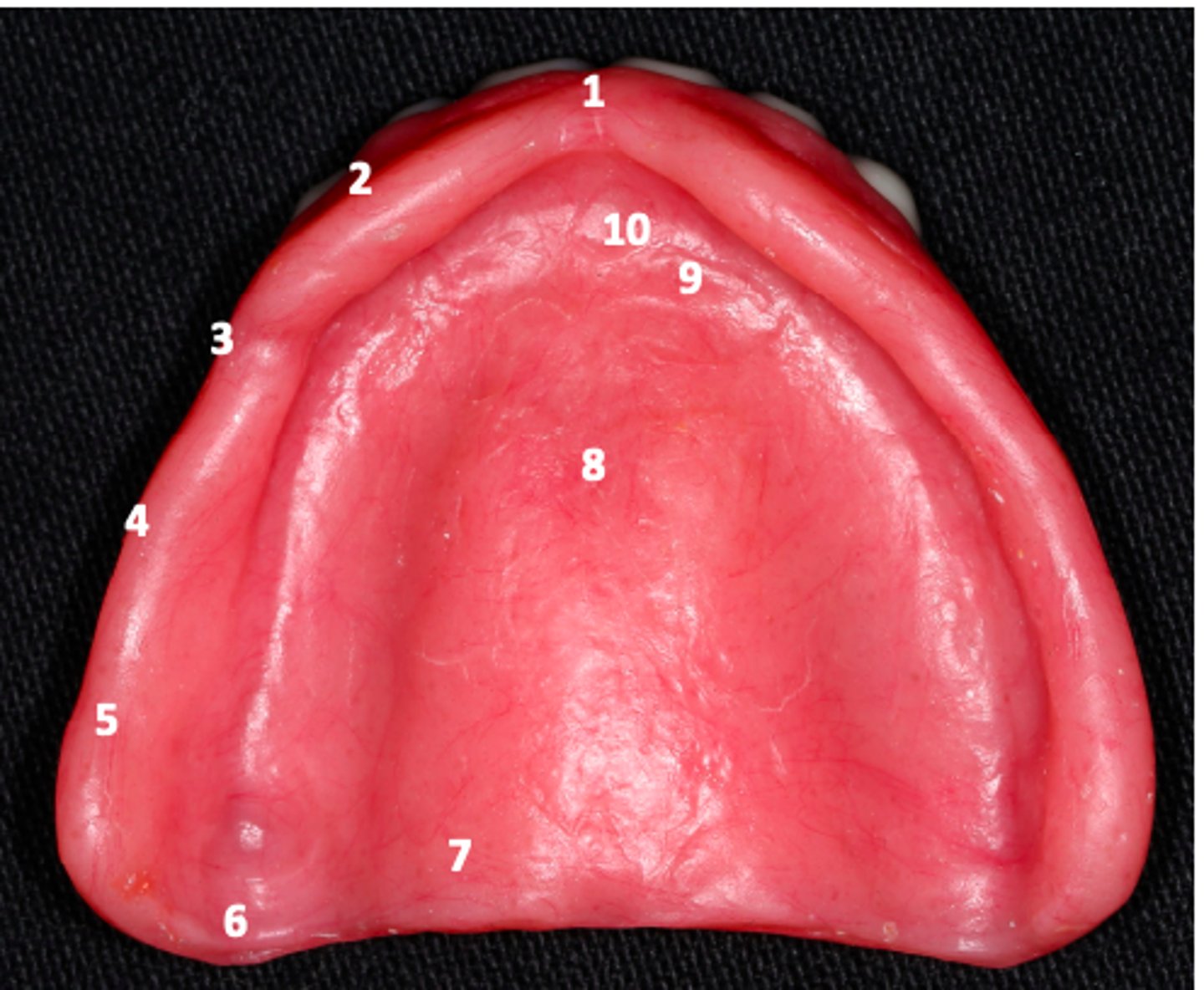
ID #10:
incisive papilla relief
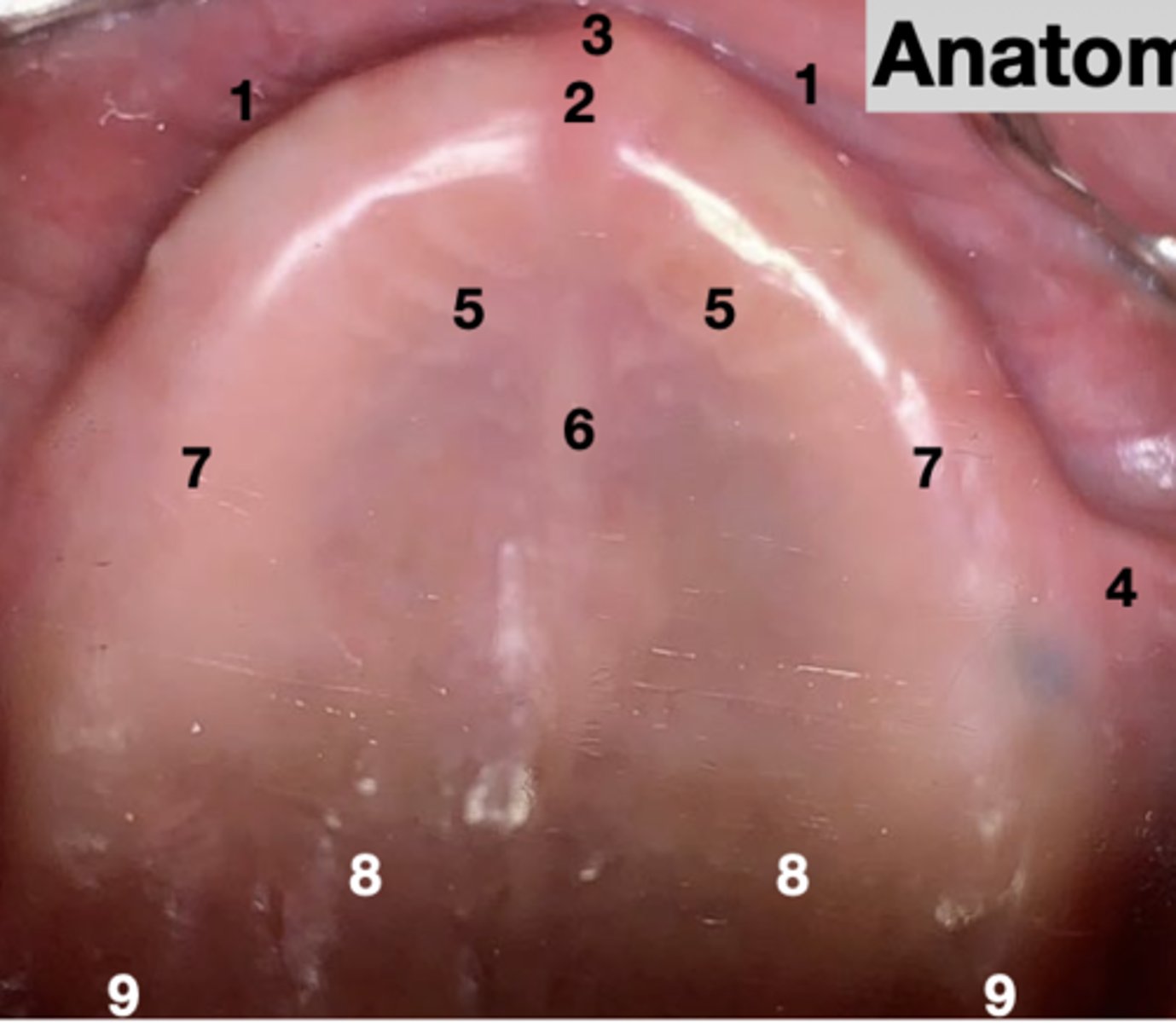
ID #6
Midpalatine raphae
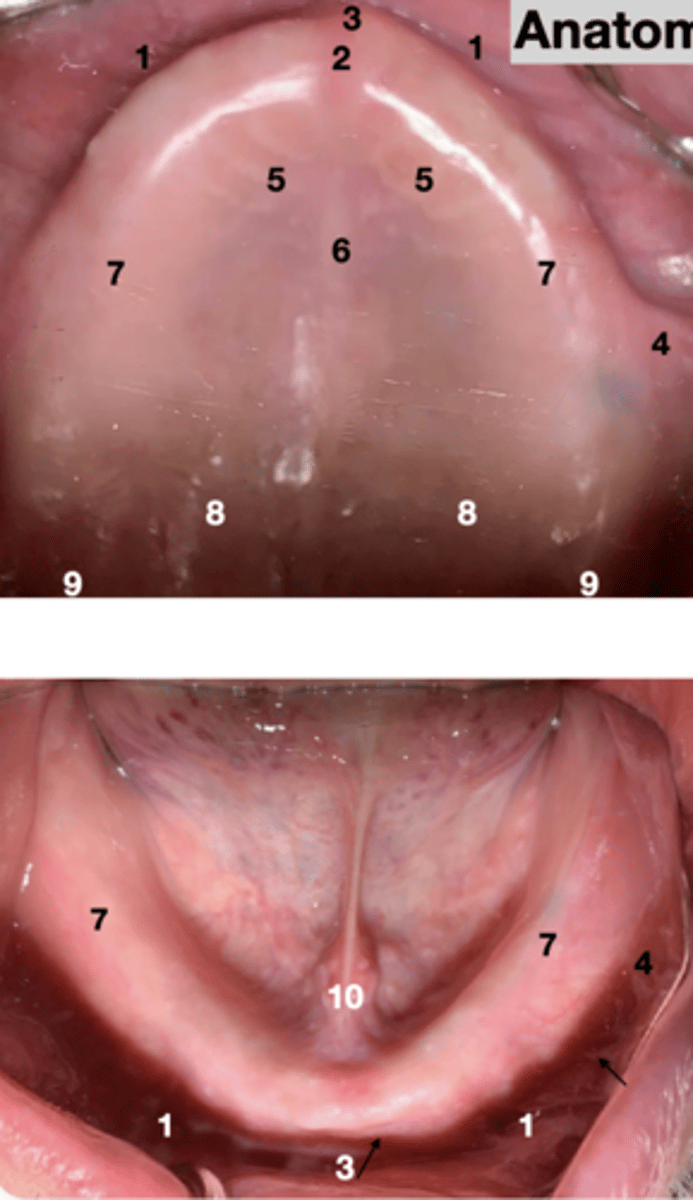
ID #7
Residual ridge
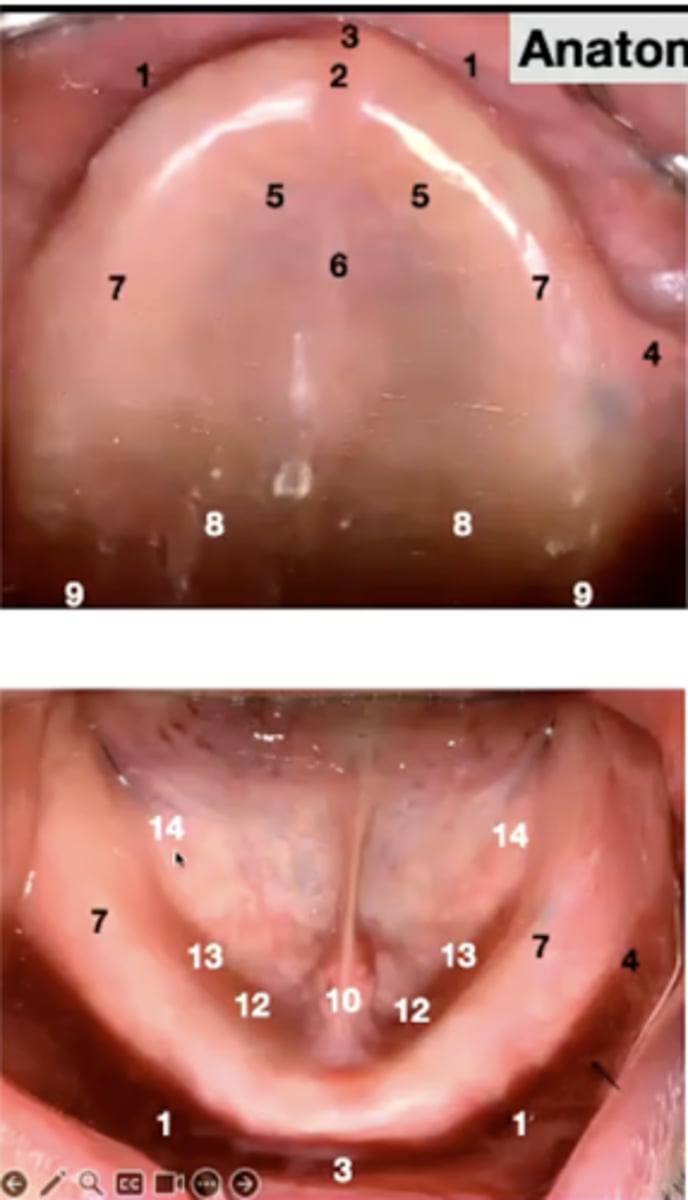
ID #12
Lingual vestibule
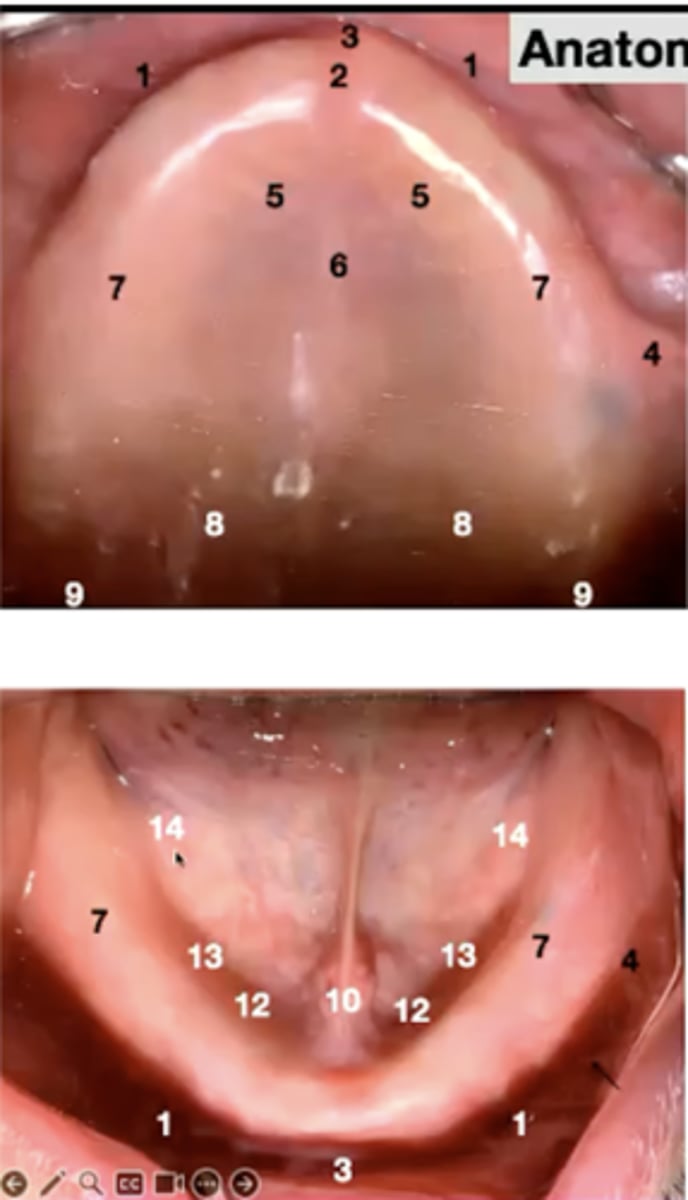
ID #13
Mylohyoid area
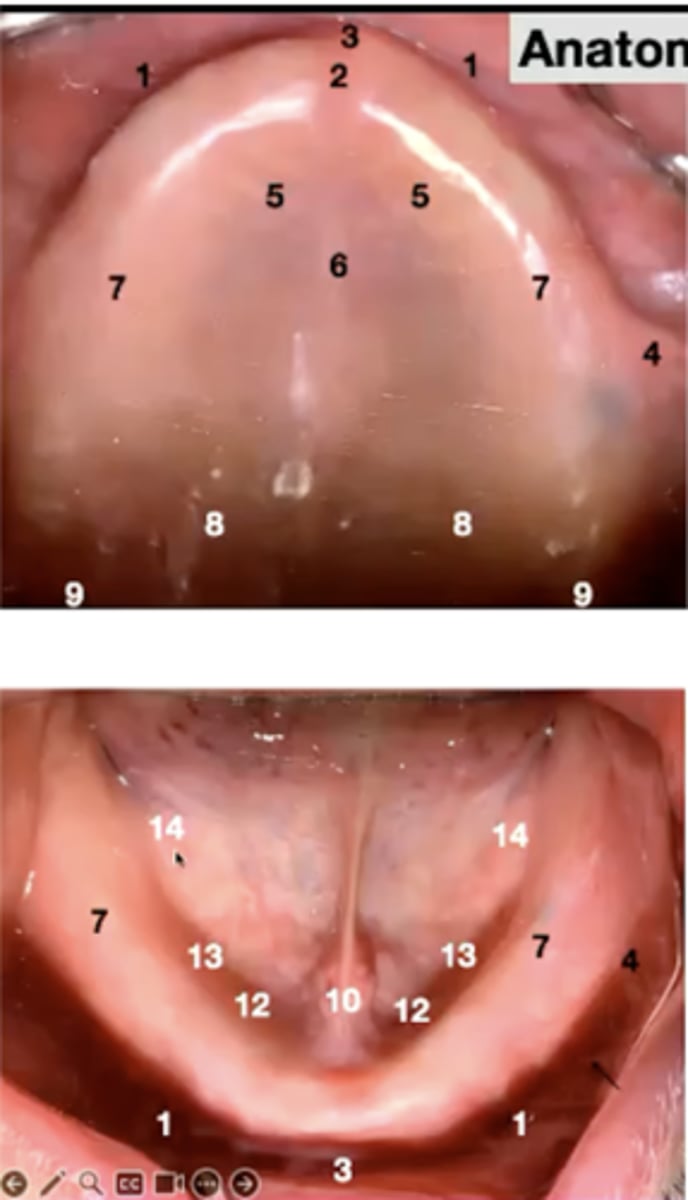
ID #14
Retromylohyoid area
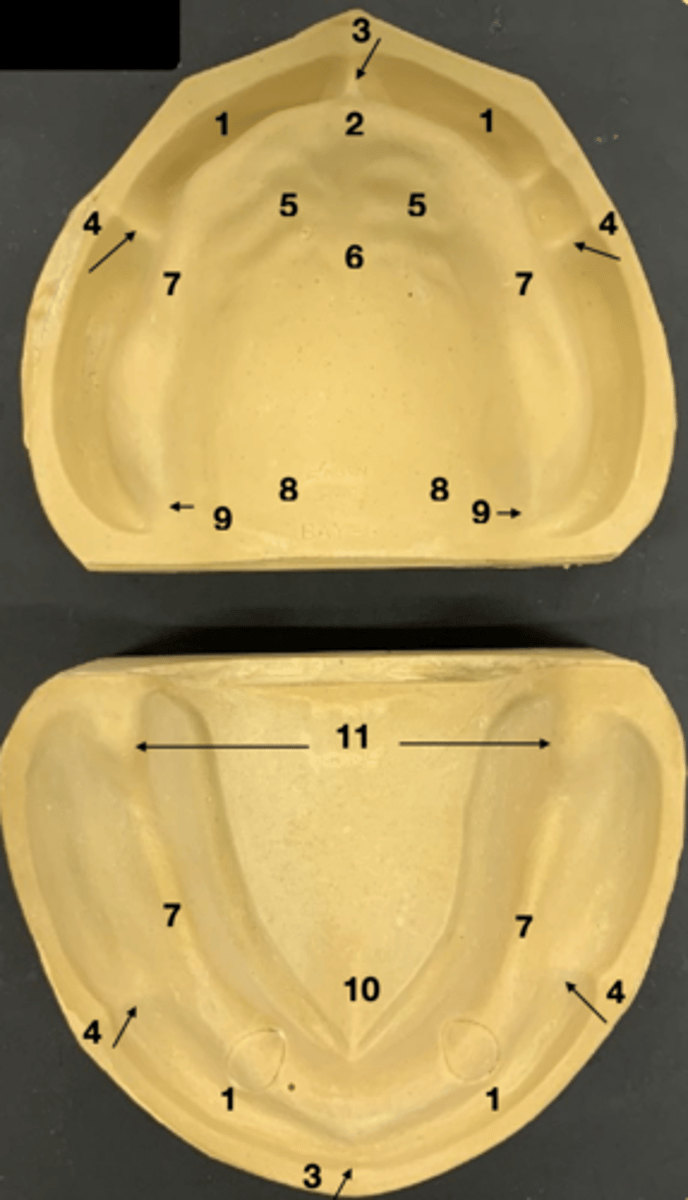
ID #1
Labial vestibule
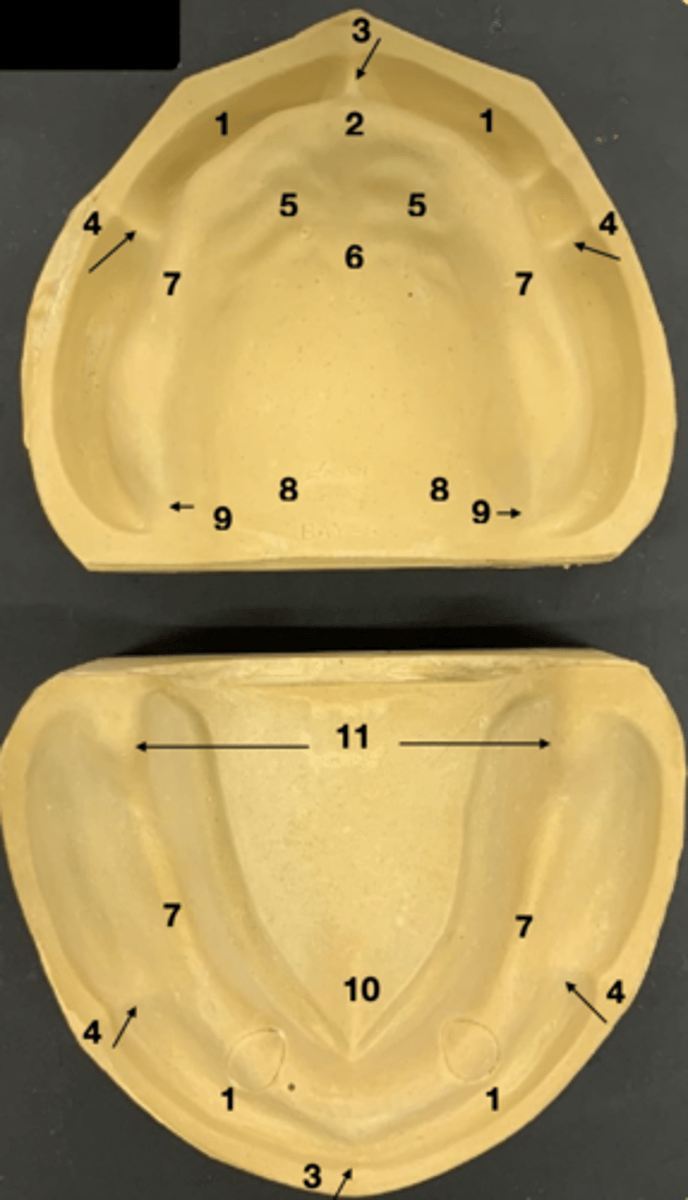
ID #2
Incisive papilla
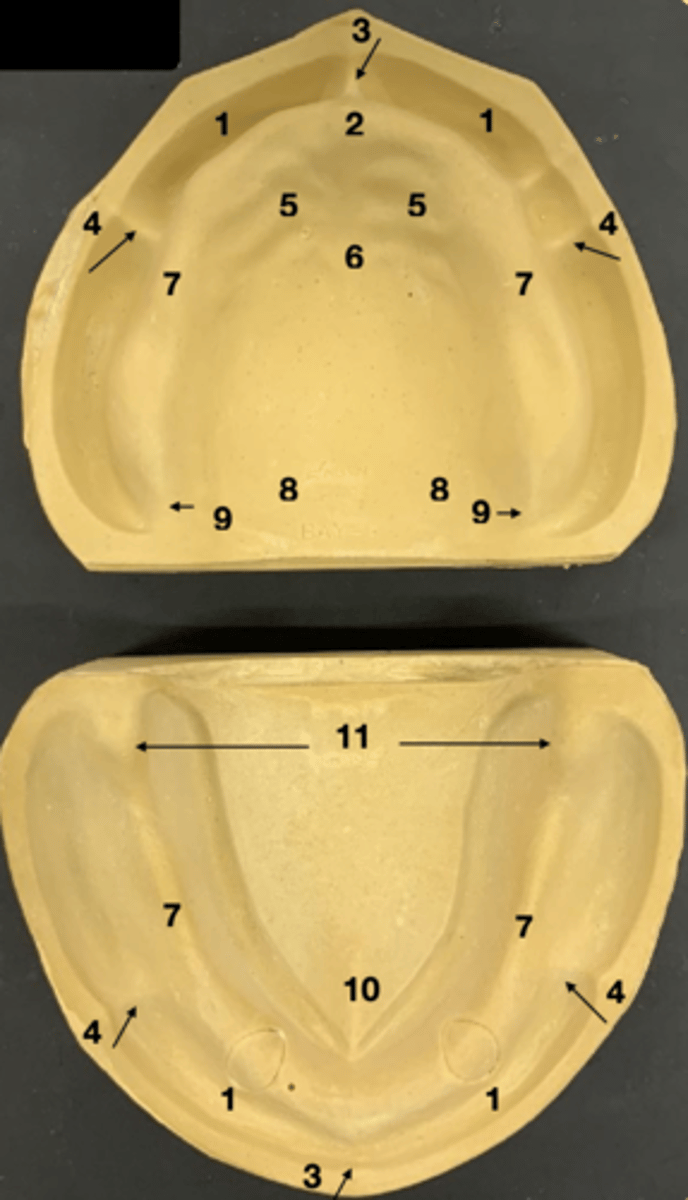
ID #3
Labial frenum

ID #4
Buccal frenum
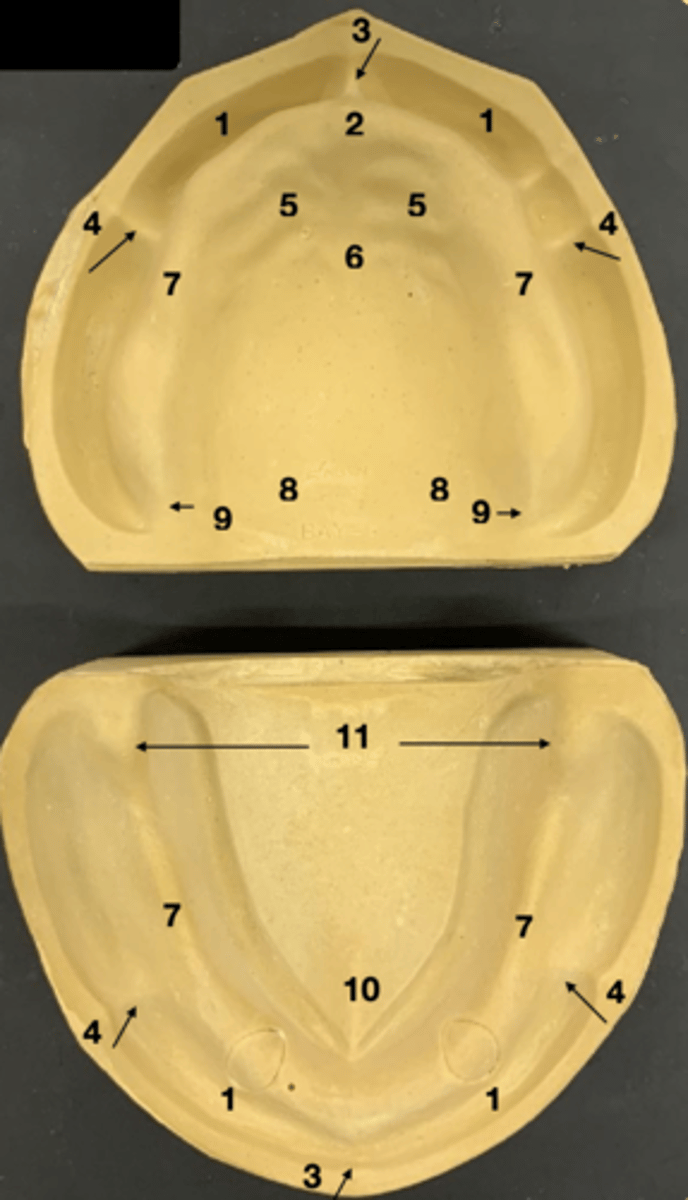
ID #5
Rugae

ID #6
Midpalatine raphae
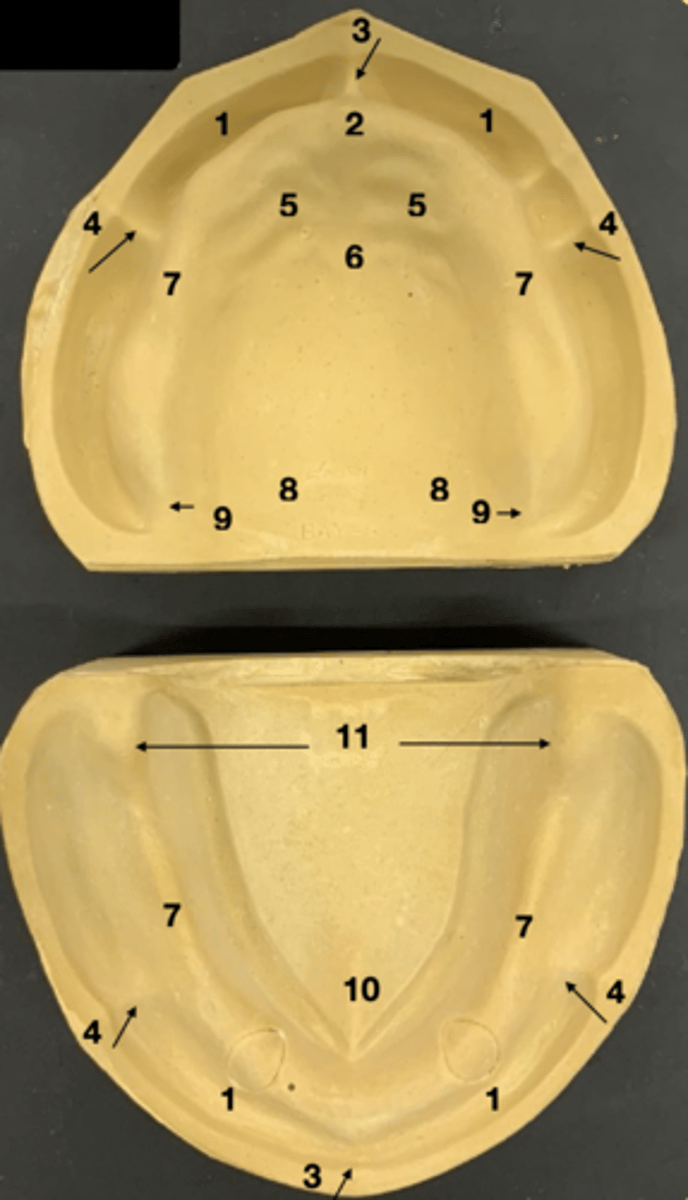
ID #7
Residual ridge